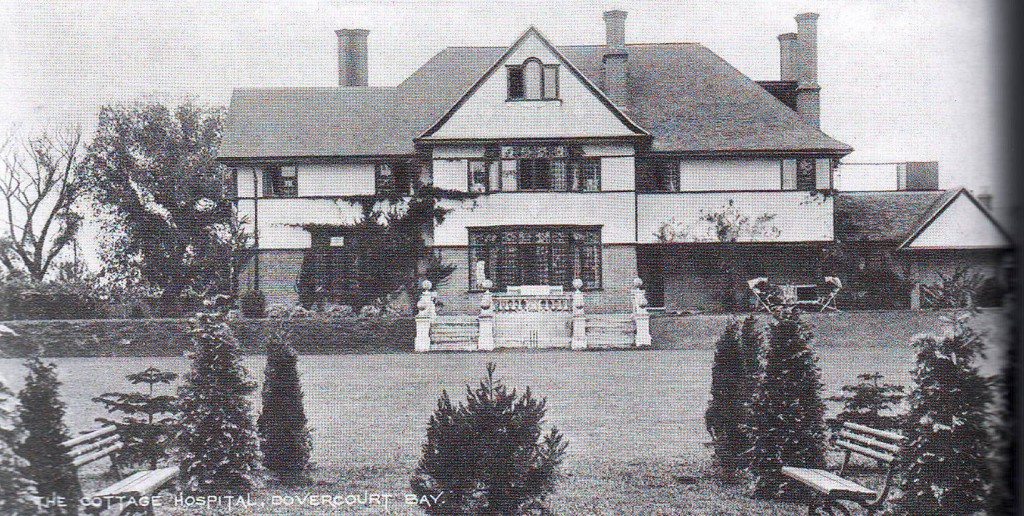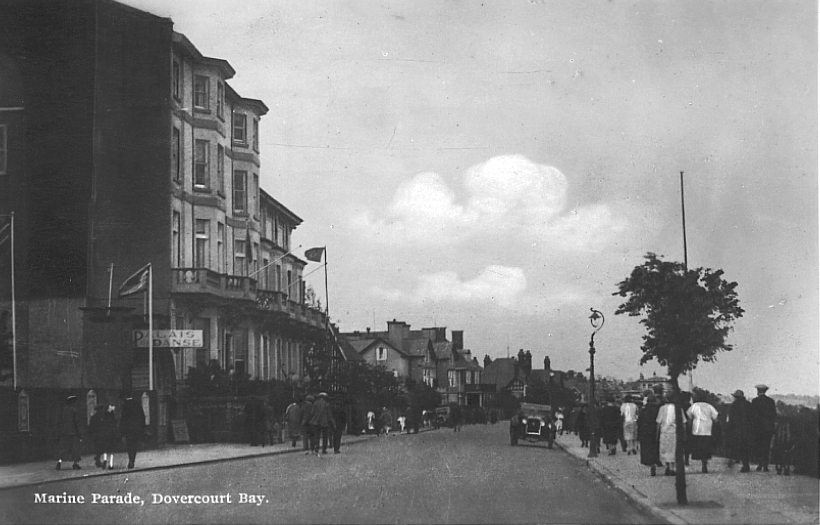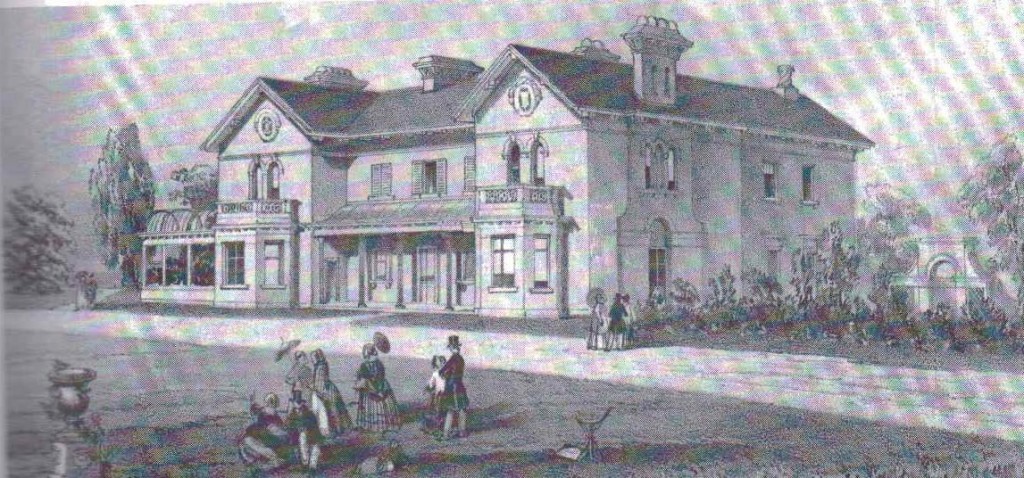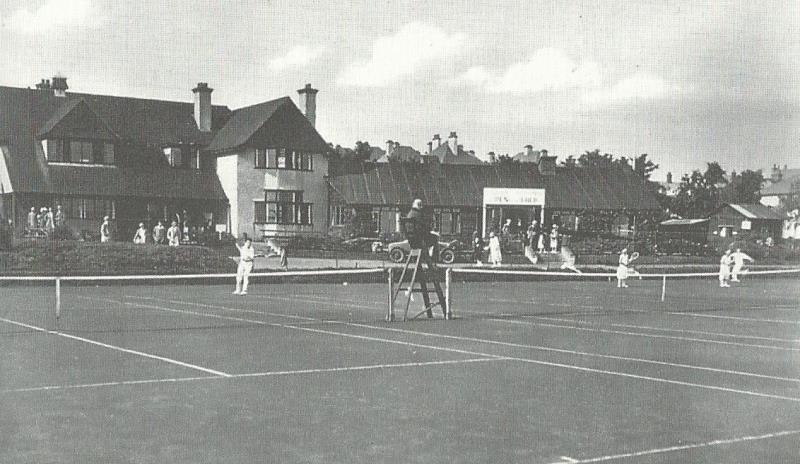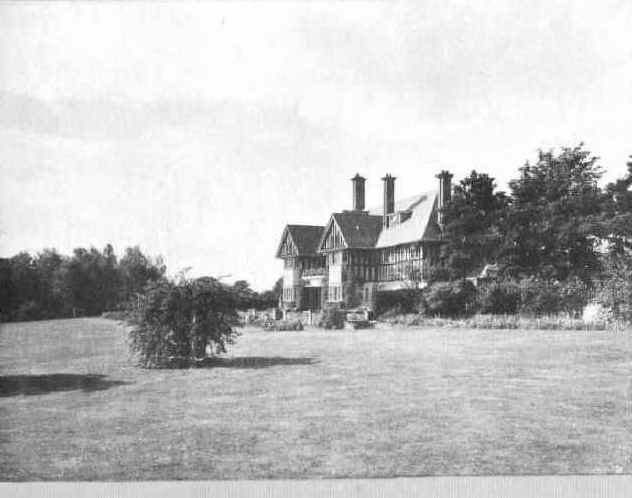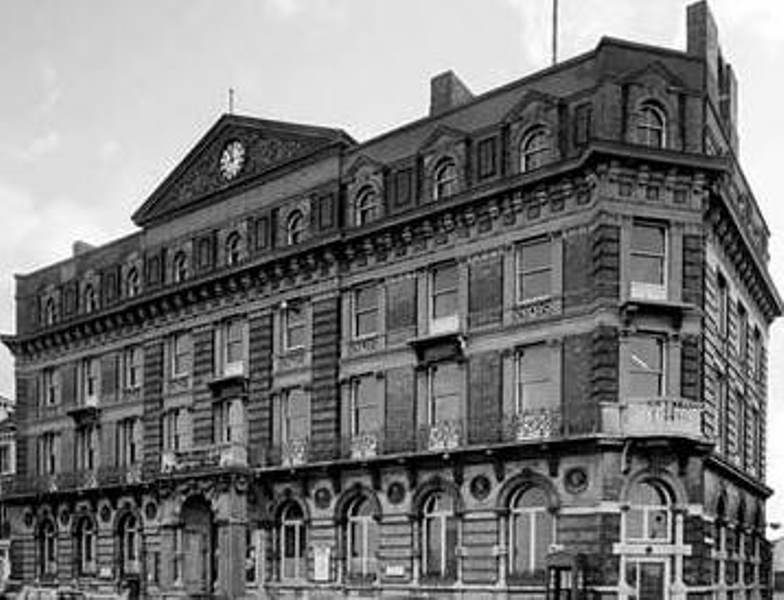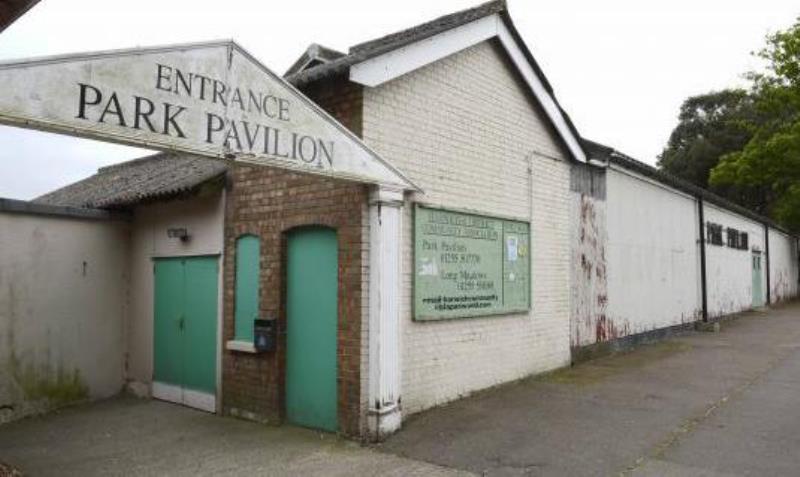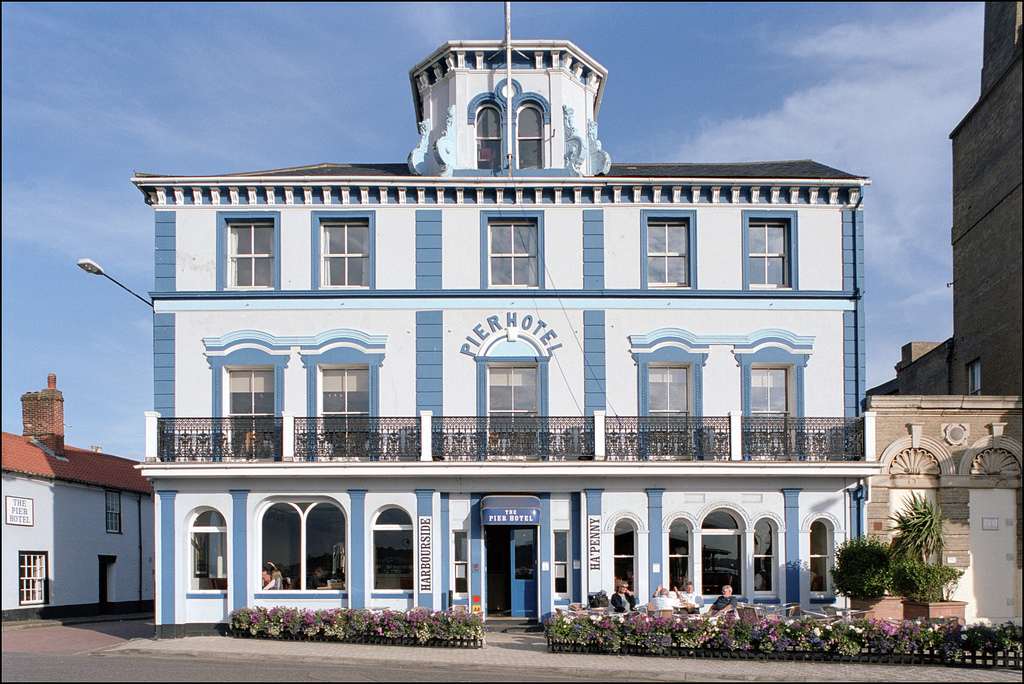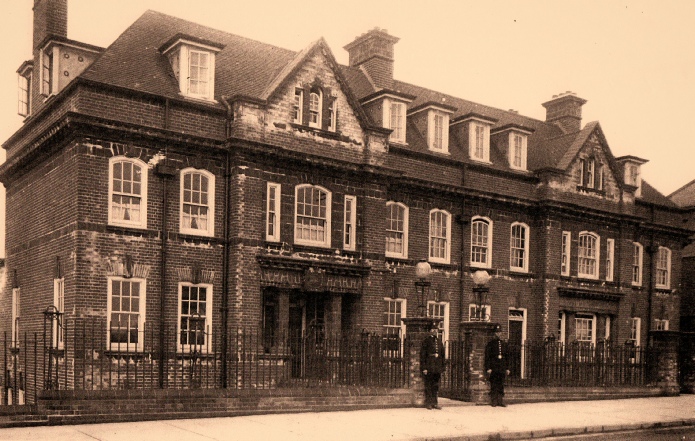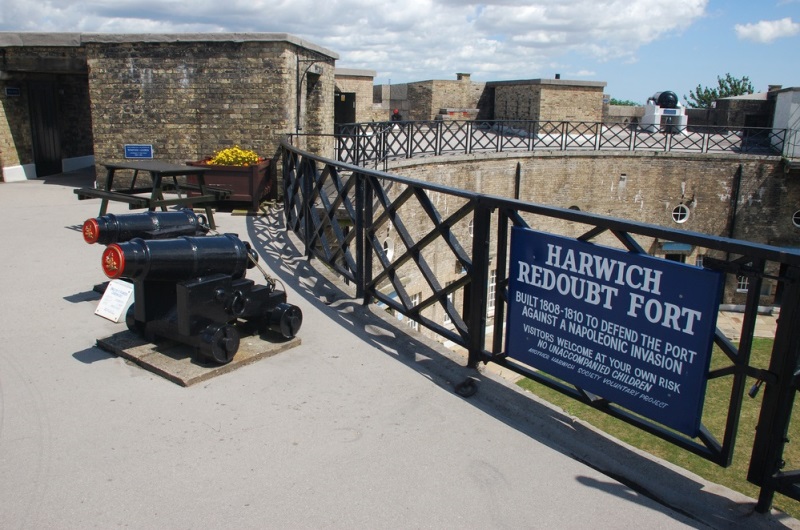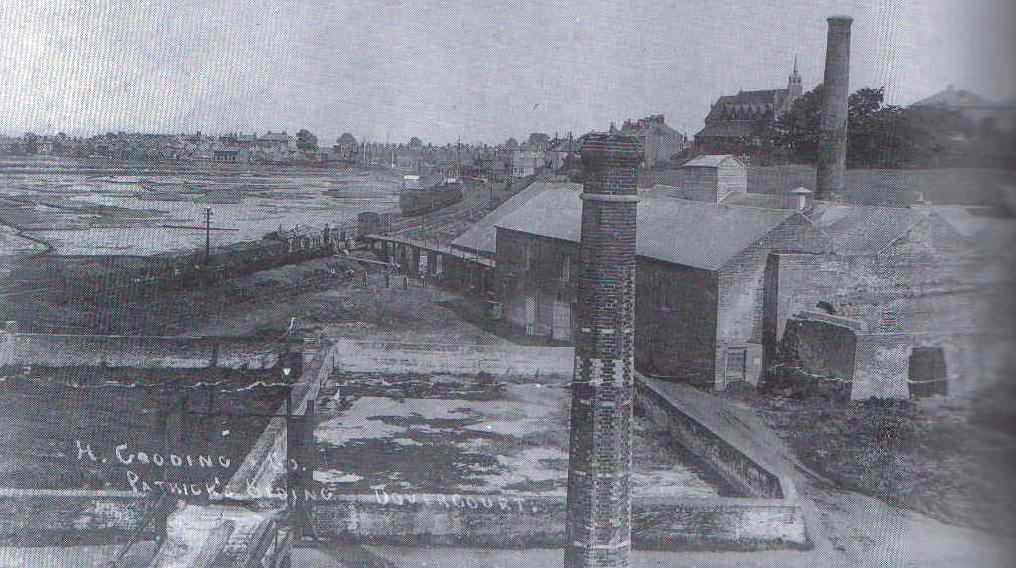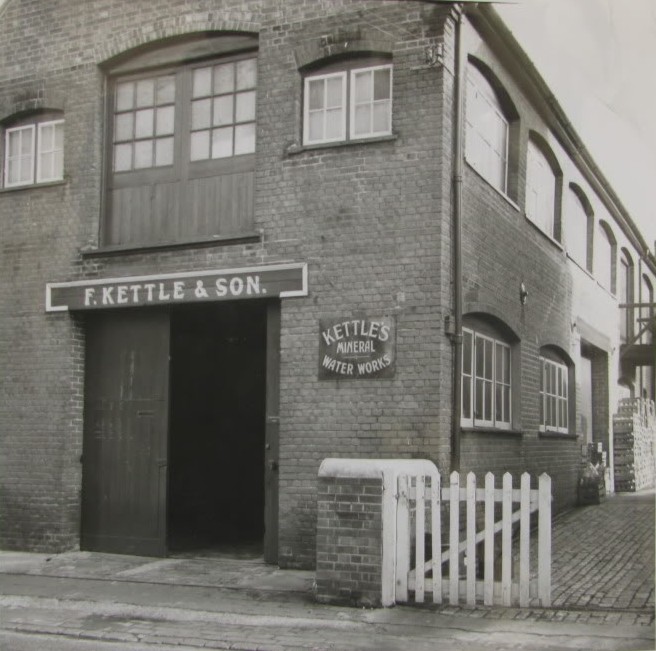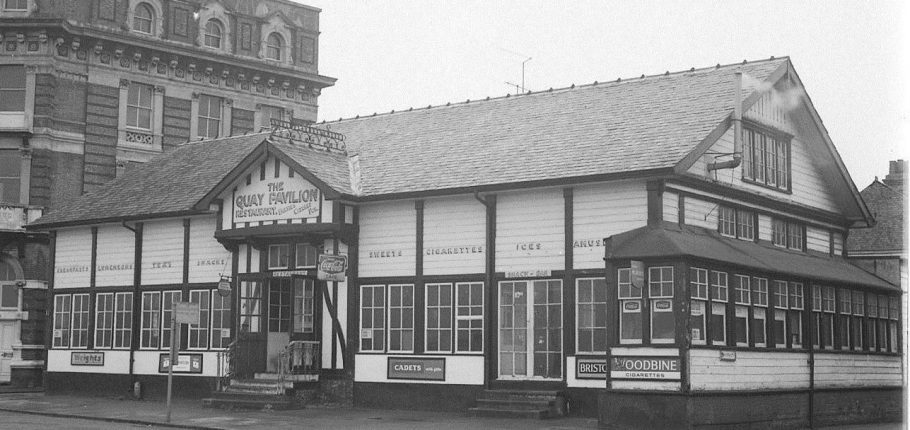
Buildings & Manufacturing
Harwich has many claims to being different from other towns – but how about the number of Buildings it has which are not today used for the purpose they were originally built? Have you ever stopped to think?
Four lighthouses, none of which is now a lighthouse, a hotel that is now flats and was once the Town Hall. a number of public houses have also been converted to various other uses, besides these buildings.
Captain Fryatt Memorial Hospital
The idea of a Cottage Hospital for Harwich and the surrounding district was first proposed by the Mayor Edward Saunders, at a public meeting on 9th February 1914.
The proposal to open a Cottage Hospital in Harwich was greatly welcomed by local people and the first fundraising demonstration raised £60. In the collection were 15,000 copper coins and only 12 silver coins- clearly everyone contributed as much as they were able. The publicity about this collection brought forth a magnificent donation from the Trustees of Thomas Whitaker’s estate, who offered £1,000 donation and £5,000 endowment for the hospital.
In December 1921 there was sufficient funds raised to buy the building for the hospital for £4,000. This private house, named ‘Rosebank’, built in 1911 was situated in an excellent position on the Main Road at the centre of the district. Over the next 20 years further land at the back and side of the property was acquired by donation or purchase, as well as Green meadows behind Rookery Farm, which was used for accommodation for nurses.
The Hospital was officially opened in 1922 by Lord Claud Hamilton, High Steward of the Borough of Harwich. An enormous crowd gathered to listen to the speeches, watch the hospital open “to the glory of god for the alleviation of the suffering and for the help of the sick, and in memory of the late Captain Fryatt
The Initial cost to buy and equip the hospital was £12,000. It was estimated at £1,200 would be needed annually to run the hospital. Additional money would be required for repairs, alteration or enlargement of the hospital. The hospital when it opened had ten beds and two cots. It was calculated that with a population of 20,000 for the entire district, eventually twenty beds would be needed.
The cost of staying in the hospital was 17s 3d per day in the private ward and 1s 7d per day in the public wards.
In the first few years there were sufficient funds to expand the hospital and the services it provided. Four additional beds were provided in 1924 in two outside shelters. These could be used in the summer. In the following year a new wing was opened, in which there was a new men’s ward with four beds known as (Abdy Ward), two private wards and accommodation for nursing staff.
The Maternity unit was opened in 1959 and thereafter most Harwich babies were born in hospital rather than at home. A large extension providing a new outpatient department was opened by the Duchess of Kent in 1973. A high dependency ward for coronary care and other cases needing intensive nursing care was added in 1979 and the Duke of Gloucester opened the Day Hospital in 1983.
Many changes have taken place in the health care provided for the people of Harwich since the cottage Hospital opened in 1922.
Cliff Hotel
Delightfully situated facing the sea, and open throughout the year, built in 1882 as the Cliff Hotel Pavilion, the Southside of the hotel was converted into Palais De Dance ballroom, the billiard room was converted into a café lounge, This project opened in 1924. A lounge between the reception lounge and the saloon bar, Became the new billiard room, the following year the café lounge was integrated into the dance hall. In the 1860s there was piecemeal development along the front at Dovercourt.
But one building that has always had a commanding presence on the Marine Parade is the Cliff Hotel. Bagshaw’s bankruptcy allowed Daniel & Sons to acquire the site for the Cliff Hotel and it was purchased by the Dovercourt Cliff Hotel Company Limited in 1883.
Cliff House
The coming of the railway brought developments at Dovercourt mainly due to the initiatives of John Bagshaw, a former East India merchant who settled in Harwich, who took over the ship yard, and planned to build a new town at lower Dovercourt. He began in 1845 by building a mansion, Cliff House, in the grounds which had become Cliff Park, and when a chalybeate spring was discovered in the grounds of Cliff house Bagshaw built the spa which opened on the 28TH august 1854 and incorporated a library, pump room, and a conservatory which was used as a reading and smoking room. The slopes from Orwell Terrace to Mill Lane were landscaped, with a grotto, shelters and a Miniature waterfall,unfortunately this all left Bagshaw in severe financial difficulties and he was declared bankrupt in 1859. After the contents of his house and the Spa had been sold and his estate broken up. After remaining empty for some years, Cliff House was demolished in 1909 and the Spa suffered the same fate some eleven years later.
Cliff Pavilion
The enclosure was replaced in 1932 by the new Cliff Pavilion which had seating for 750 people, Over the 40 years the cliff pavilion hosted countless dances, exhibitions, concerts and shows. Sadly In June 1971 the pavilion was demolished as part of the new promenade construction scheme. Holidaying in Britain was starting to become less popular, and after cracks started to appear along marine parade in 1970, the council decided to allocate £ 580,000 to build a new Promenade further out to sea and landscape the cliffs,
Sadly this required demolition of the Cliff pavilion and the Gables Hotel in 1972.
Customs House
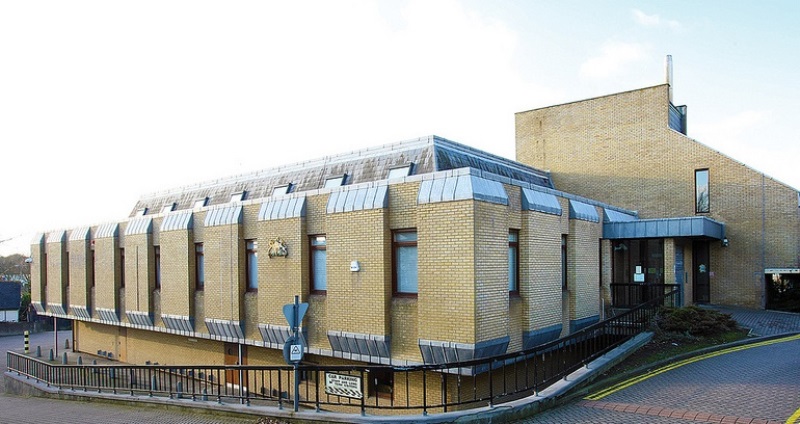
Customs House, Dovercourt
The new purpose built architect designed Customs House was opened in 1982, the building is situated between Parkeston Quay and Navyard Wharf and was constructed in yellow brick, on steeply sloping ground between the Tower Hotel and Bobbit’s Hole pond. Staff from the old customs house in Hamilton House, Parkeston, were accommodated in the new office along with staff from various offices.
This was the fourth customs house in Harwich as far as we know. The first was situated in West Street, Harwich, and was adjacent to the edge of the Town Quay. The Great Eastern Railway moved from Harwich and opened Parkeston Quay in 1883. The Customs eventually opened the next Custom House on Parkeston Quay at the turn of the century. It was in the old Eastern Station Office at the eastern end of the Old Continental Office Block.
From 1933 to 1939 Customs occupied Hamilton House on Foster Road, Parkeston. Hamilton House, named after the Chairman of the Great Eastern Railway, had been built as an engine drivers hostel. During the First World War it became a webbing factory and after the war, a corset factory. During the Second World War, it was taken over by the Admiralty and the basement was converted and extended into a Naval Operations Headquarters. It re-opened as a Custom House in 1945, which lasted until 1982.
Dovercourt Spa

Dovercourt Spa
The design for Dovercourt New Town with the magnificent crescent and terraces was very much in the manner of the grand spas, but it came too late to be fully realised. Nevertheless, when Dovercourt Spa opened on 28th August 1854, it was a fine building with a Conservatory, a Reading Room, a Saloon and a Library as well as the Pump Room. The opening coincided with the completion of the branch line to Harwich of the Eastern Counties Railway, a day of great celebration for the shareholders in the E.C.R.
The Spa House was said to be a “pretty building erected on a broad walled terrace at the base of the cliff sheltered from northerly winds and overlooking the ocean.” It is described as “an ornamented cottage something in the style of a Pompeian Villa.”
In the Pump Room, for the purpose of drawing water from the cliff, was a dolphin-headed bracket underneath which was a shell basing to receive the surplus. In the other wing was the library from which a handsome stained-glass door containing a beautiful portrait of Queen Elizabeth – the great patroness of Harwich – opened into the Conservatory, filled with a fine display of climbing plants reaching up to the transept roof supported on iron pillars. Beyond this was a small Italian Garden from which, passing under a rather quaint archway, a series of steps led up to Dovercourt New Town.
Dovercourt Sport Club
The Squirrels, as we once knew it, was originally the Dovercourt Sports Club, Founded with the aim that its members would possess a club house and grounds for social and sporting purposes which will add greatly to the attractions of Dovercourt and to the pleasures of residents and visitors”. Under the chairmanship of Mr JW Carlyon-Hughes and on the 14th of October 1911 a site was purchased and the work of building a Clubhouse and the construction of seven tennis courts commenced.
The Clubhouse was designed by H Steward Watling and BJS Carlyon-Hughes, Architects of Dovercourt who designed many local houses, built by Blay Ltd of London and furnished by RD and JB Fraser of Ipswich.
The Elco
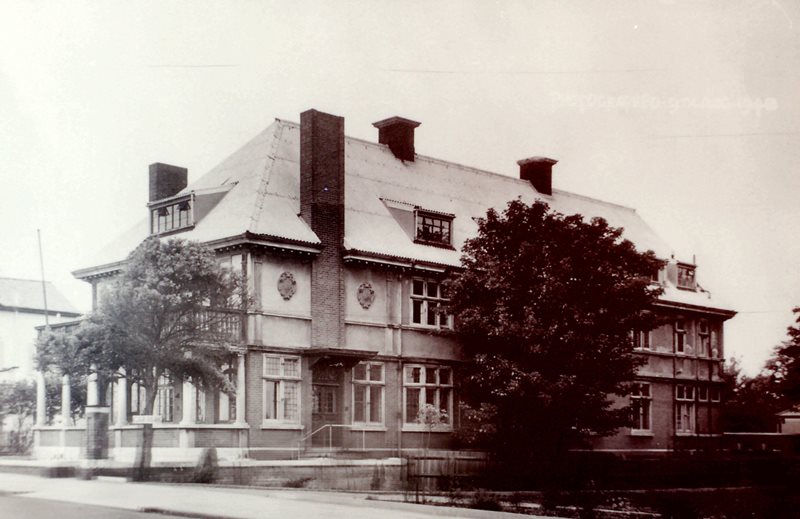
The Elco
Often suggested as a suitable building for municipal offices, Cliff Hall was used as café and hotel before the war, after being unoccupied for many years. At the outbreak of war it became Garrison Headquarters and was damaged in the roof by an incendiary bomb raid early in the war. built in the 1900’s with the holiday trade in mind, it had double glazed windows, which were rare. during the First World War the building was used as a hospital, WRNS were billeted here during the Second World War.
It was for a time used was holiday flats but then became empty and remained for many years as an abandoned eyesore.
Dovercourt Building – A Total Loss
(To the Editor). August 13 1948.
Sir,-While the Chancellor is stumping the U.K. Telling us we must all work harder or go “bust” (actually we are already insolvent, I suggest) and while Press and radio plaque us with the need for economy and National Savings, that same Press and radio publish the findings of the committee on National Expenditure showing how the savings wheeled out of us are squandered by our precious and expensive Government.
We are also condemned to short rations and pamphlet size newspaper, not so much because of short supplies or shortage of dollars, but because so much of our wealth is being squandered.
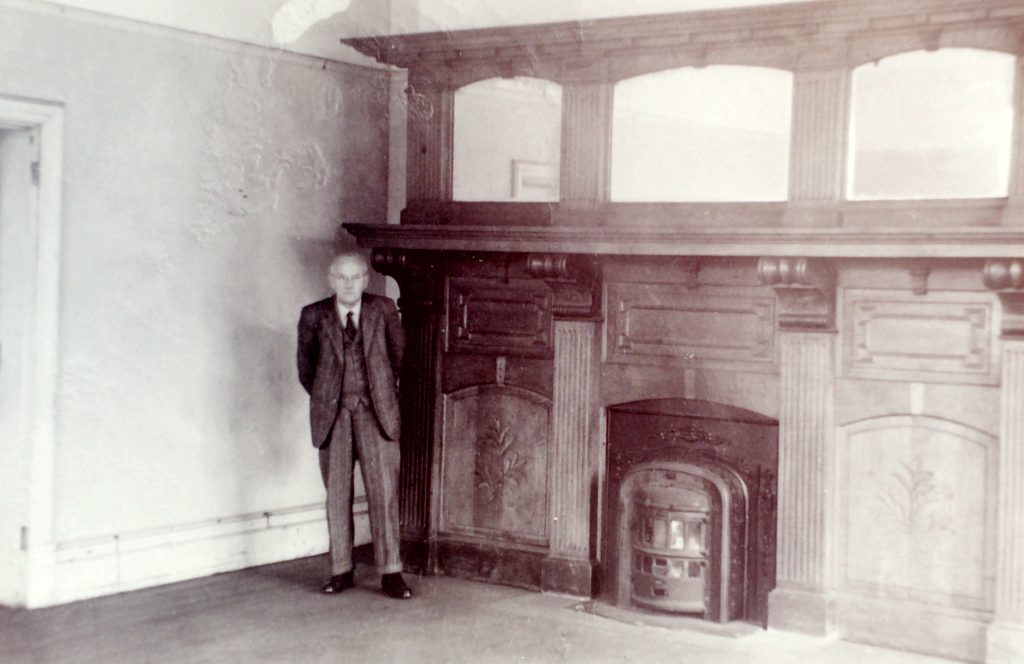
The Elco
Let me give just one local example, which none of us can avoid seeing. The “Elco” Café and Hotel on Marine-parade, Dovercourt, has after nine years combined war and post-war years, been classified as a “total loss” with a salvage value of “nil.” This is a repetition of a classification made by the War Damage Commission way back in the early forties. But we all know that the “Elco” did excellent service for Wrens throughout the war, but we do not all know that it is still held under requisition by the Admiralty, though they do not pay me, as owner, any rent, and I am denied any use of that property. Most of you will say that it is a shame, but it my affair and with that wash your hands of it. But wait a minute, That property now again classed as a “total loss” is held unused by the Admiralty who are spending over £1,000 per year of taxpayer’s’ money in rates and wages for two watchmen, and we, the people of this country, are taxed into ruin and despondency and then lectured on the vital needs of economy and national savings. Do you remember the poster showing a white elephant with the query “Why buy if you don’t need it?:”
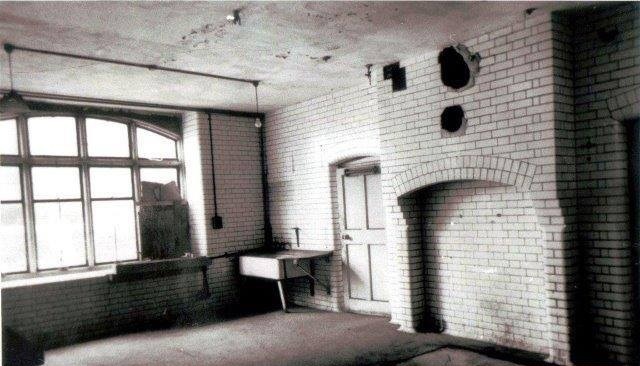
The Elco
Well, what of my pink “Elco” seeing it not used and has not been for the past three years? Why is it kept from me and from beneficial use and why are two watchmen kept from useful work? Is it not strange that only this week another Government Department, the Eastern Electricity Board, wrote and told me that I could not expect to receive an electric kettle for a long, long time, as they had a waiting list extending over three years.
Actually I have been on that list over a year. Do our departments ever realise how many electric kettles I could make at the “Elco” or how many old folks or young folks could be housed there, or how many visitors could be “hoteled” there, or how many maternity cases could be accommodated there, or how much public money could be saved if only liabilities of war damage payments, and now it is up to the W.D. Commission to make good that war damage.
I further suggest that it is up to the Admiralty to release my building and two watchmen, and to stop paying over £150 per year in rates, and up to £1,000 for watching, etc.
Finally, I invite Sir Stafford Cripps and the Committee of National Expenditure to issue a little White Paper on this subject. Sir Stafford knows all about it although he conveniently abstains from answering my letters.
Is this Socialism in our time? J.Elliott, Mill House, Dovercourt.
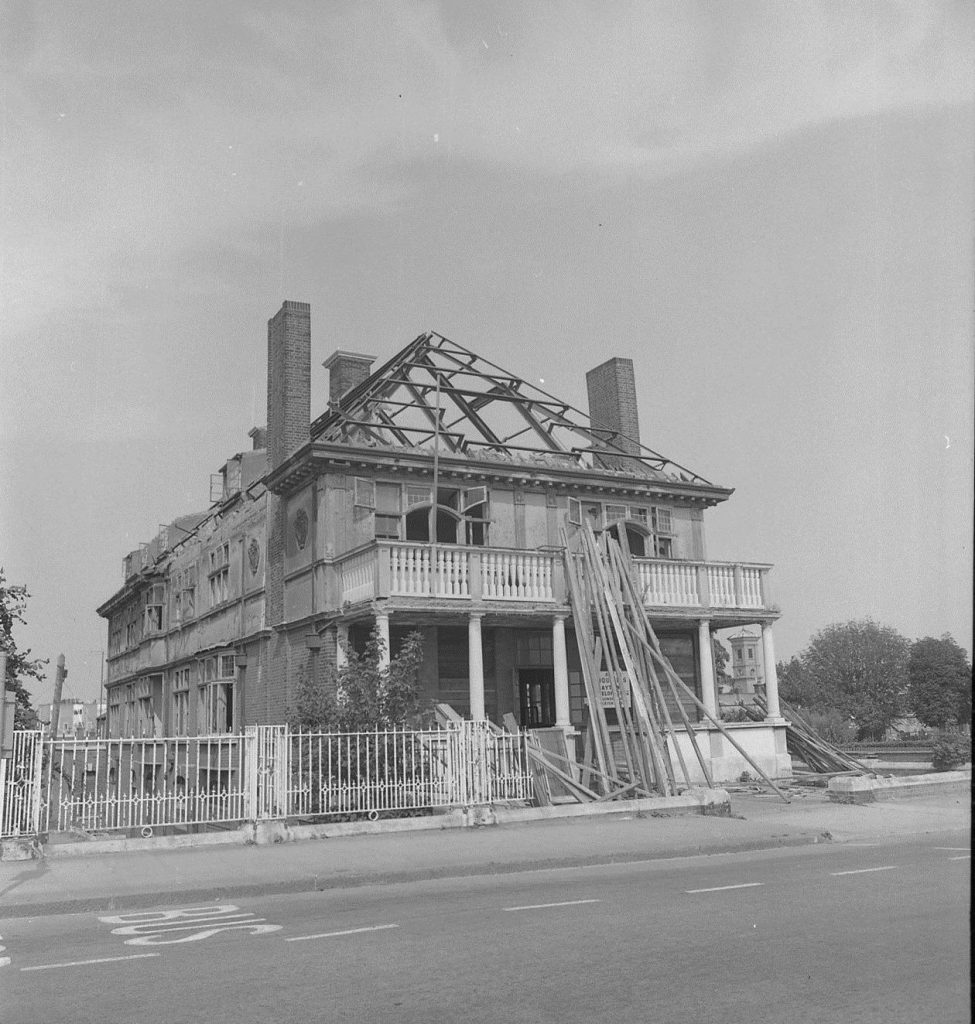
The Elco
The Elco was finally demolished in August 1972 and replaced with accommodation for the elderly as Wimborne house.
The Electric Palace
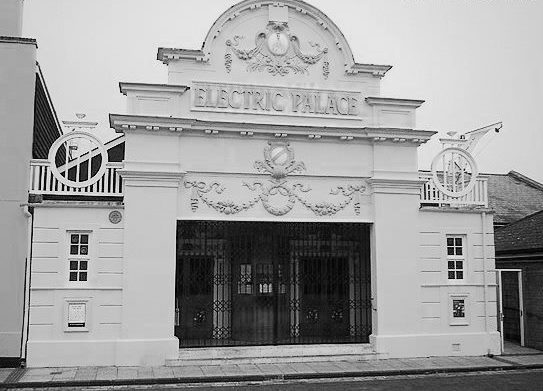
Electric Palace
With the introduction of the Cinematograph Act 1909, which imposed strict fire prevention regulations on any venue in which films were shown to the public, it became effectively impossible to put on a legal film show in a fairground tent. Hence Thurston decided to build a permanent “Picture Palace” in which he could continue to screen films to the public. In 1911 he was able to obtain a lease on a site in Kings Quay Street, Harwich which had become vacant due to the previous building on the site being destroyed by fire. He engaged the young architect Harold Hooper to design the building, which was to be known as the Electric Palace. The Electric Palace was built at a cost of £1,500 and opened on Wednesday, 29 November 1911, the cinema was an immediate success and continued to be financially successful through WW1 thanks to the presence of Navy personnel in the port of Harwich. However almost as soon as the war was over business at the “Palace”, as the cinema was now called, went into decline due to the loss of population from Harwich to nearby Dovercourt and competition from the newer, plusher, cinemas.
In April 1975 the Electric Palace Trust was formed with the aim of restoring the building so that it could, again, be used as a fully operational cinema.
The grand Re-opening was on 29th November 1981, the 70th anniversary of the original opening.
Fire Station
It was suggested that a horse-propelled fire engine be purchased and a fire station be built on the vacant land next to the new Electric Palace cinema where two cottages had been. A vacant house on the corner of Wellington Road and Kings Quay Street could become the station officer’s house. The council accepted Mr Newton’s tender to build the new fire station at a cost of £ 1041. The new fire engine arrived in November before the fire station had been completed.
The old fire station in Cow-lane, closed in 1966 and is now a group youth hostel run by Harwich Connexions as the 1912 centre.
Foresters
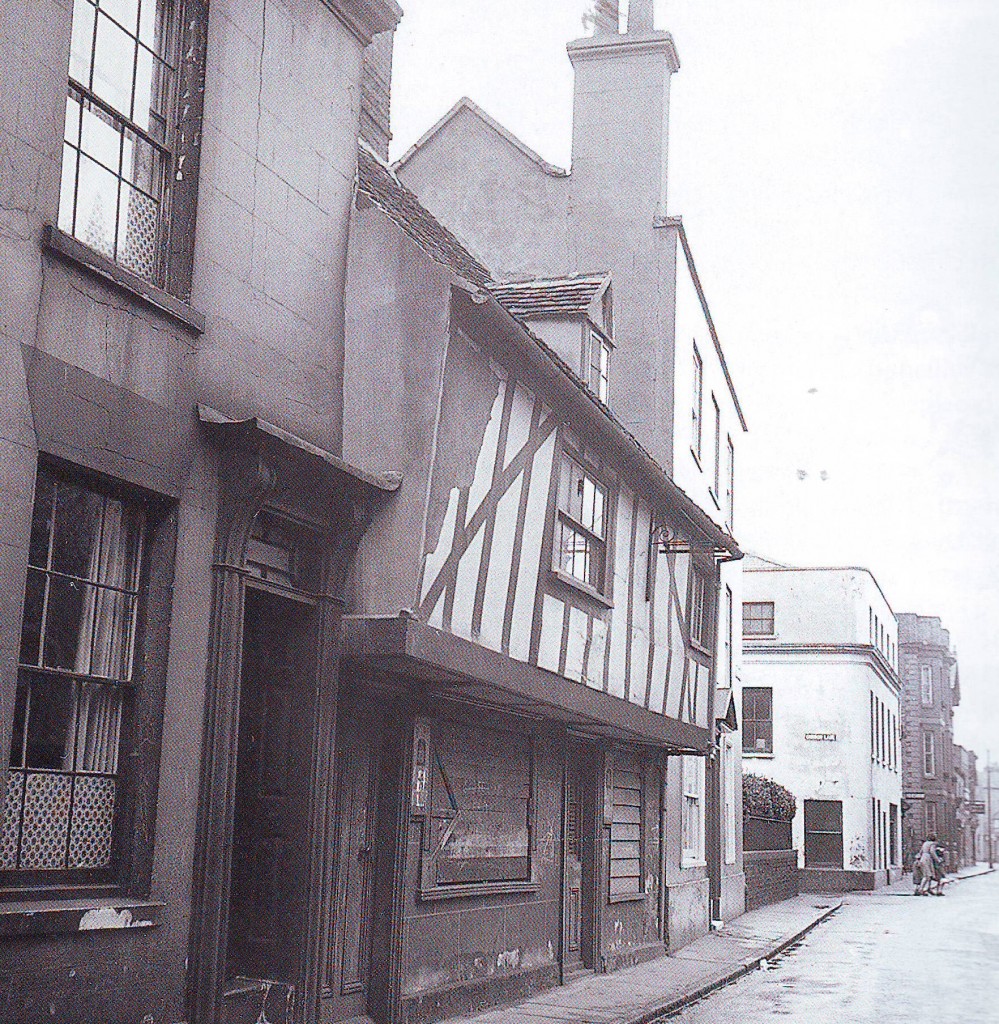
Foresters Arms
Foresters, 5 Church Street, Harwich is a timber framed and plastered house which was built circa 1450. It is thought to be the oldest house in Harwich and was ‘Foresters Arms’ public house from 1800 to 1940, when it fell victim to an incendiary bomb during WW2. It stood derelict for 9 years when it was bought and lovingly restored by the late Harwich Society President, Mrs Winifred Cooper and her husband. On her death in April 1999, Mrs Cooper left Foresters to the Harwich Society so that it could be used as a resource centre for the Society. In 2000 the property was rewired and burglar alarms fitted, to allow Foresters to be used as a Resource Centre, including a Committee Room and Library.
The House Committee commissioned Russell Thomas, a member of long standing, to design and make a table for this room. Made of light oak, it was an oval table with hollow centre to seat 20 people, made in sections for ease of assembly. It as felt this would be a fitting memorial to Winifred, someone whom the Society owed so much, as well a being a good investment.
The Grange
Probably the best known and best loved house in town. It was built in 1911 as a seaside cottage for the Lilley Sisters and subsequently sold to Essex County Council in 1939 for £6000 to be used for educational use. In 1971 with the creation of a new comprehensive school on the site of Sir Anthony Deane School. The Grange became a Sixth Form College. In June 2003 The Harwich School announced its intention to sell The Grange and its grounds for redevelopment. The Grange is a listed building of special architectural or historic importance, thus conferring some protection on the building.
The Grange is a fine example of its period and is completely unaltered despite being over 100 years old.
Great Eastern Railway Hotel
The Hotel was built by Thomas Allom in ‘the free Italian or mixed style’. The first stone was laid in April 1864 and was opened on the 12th July 1865. Ten roundels on the front portray national historical figures. The facia for the hotel name is under the clock. The ground floor boasted a dining room, coffee room, smoking room, a private billiard room and two large rooms with partitions that were used for private functions. Four bedrooms and six standard bedrooms were also situated on the floor. The second floor comprised of fourteen bedrooms all of which were fitted with stoves and mantle pieces.
Situated on the third floor were another fifteen bedrooms and a water closet. On the roof was a 70 x 10 promenade protected by iron railings. The hotel was closed on the 27th April 1908 met with much opposition from local traders, the council and general public felt its closure was affecting their services and lobbied a hotel committee to reconsider. Having been closed down, there were plans to reopen in 1912, in response to the growing importance of Harwich as an East Coast Naval base. The whole front of the building was turned into a lounge and a billiard room was added. There were five or so bedrooms and a large room was devoted to the Royal Harwich Yacht Club. As a final refinement, electric lighting was planned to replace gas. The continental steamship committee was eventually successful: the hotel was refurbished and re-opened on 30th march 1912.
The Guildhall
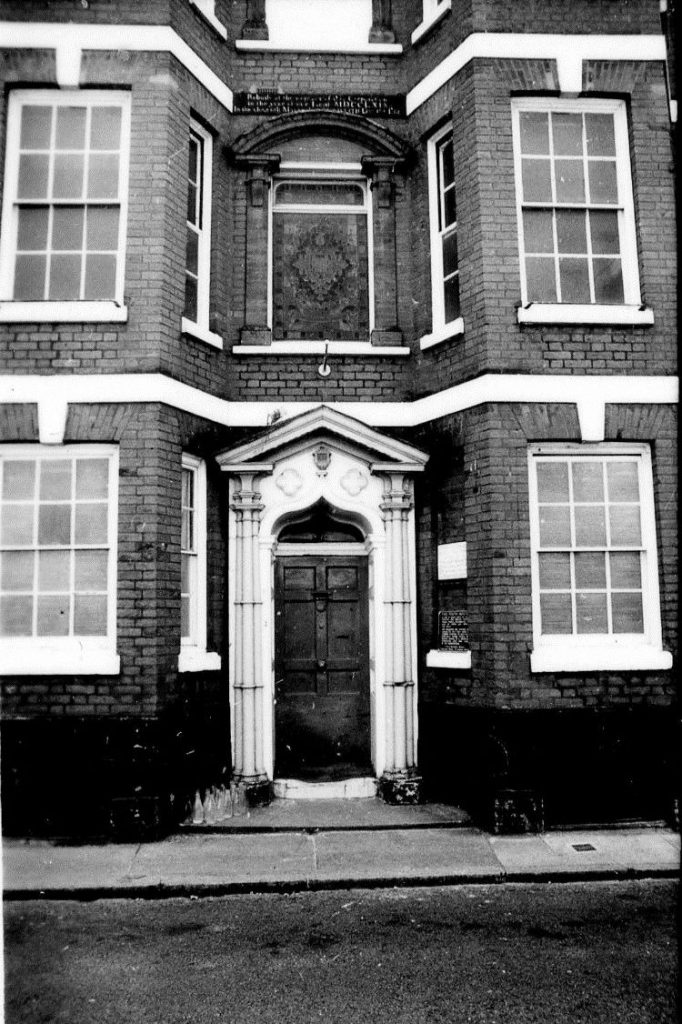
Guildhall
Harwich’s Guildhall is a Grade One Listed building dating from the seventeenth century.The Ancient Guildhall in Church Street, as rebuilt in 1769. The Council Chamber and other rooms may be viewed. The old jail contains unique graffiti of ships. Interesting documents showing the connection of Harwich with Pepys, the Pilgrim Fathers and the settlement of Virginia. The wealth of history and heritage that it contains, along with its remarkable architecture, make the Guildhall in Harwich a fascinating place to visit. A unique feature of the Guildhall is the Carvings room, once used to hold prisoners waiting to be tried or sentenced. etched into the bare, wooden walls of the room are elaborate carvings of ships, gallows and symbols designed to ward off evil spirits, some of which date from the end of the eighteenth century. Each May after the council elects Harwich’s new Mayor, the ancient ceremony of Kitchel throwing takes place. Kitchels are small spiced cakes, baked locally and the new Mayor throws them out of the window of the Council Chamber to be caught by the waiting crowds below. There is no entrance fee but to ensure that the Guildhall is open when you plan to visit please telephone The Clerk to the Council on 01255 507211 between 9.30am – 1pm Monday to Friday.
High Lighthouse
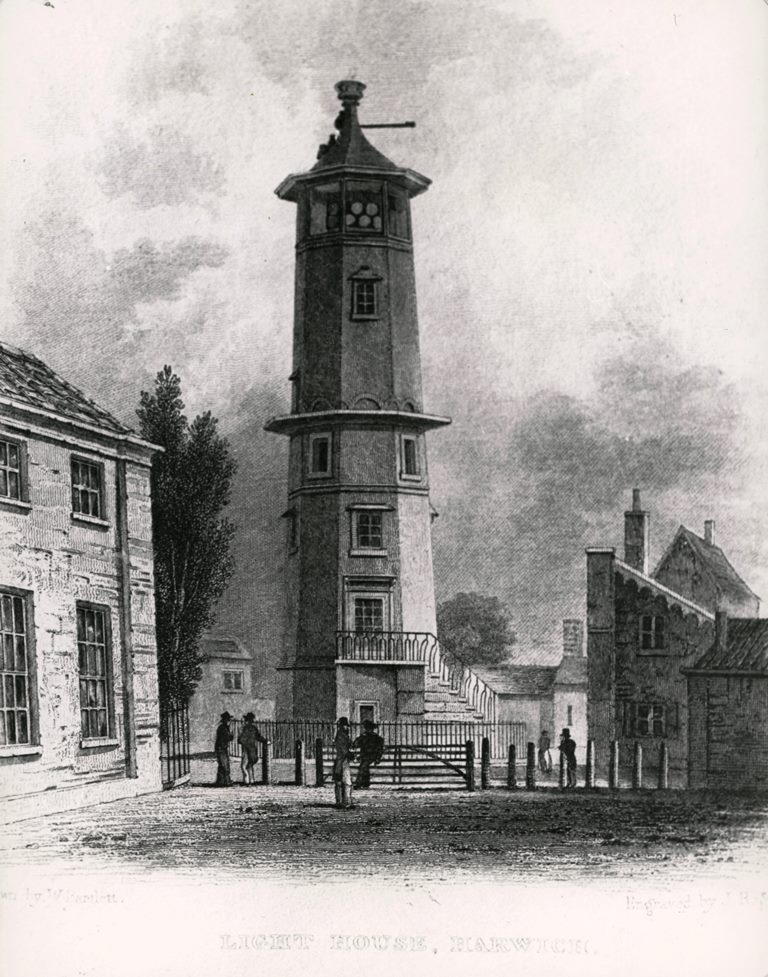
High Lighthouse
The Entrance to Harwich old town is dominated by the High lighthouse which Stands at the south end of West Street. This 90ft. high grey brick tower was built in 1818 under the supervision of John Rennie Senior. Built to replace earlier wooden ones. Belonging to General Rebow who became very rich by charging 1d per ton light duties on all cargoes coming into the port. But in 1836 Trinity House acquired the Harwich Lights from General Rebow for £31,730, there being 12 years and 5 days remaining of his lease. It is suspected that Rebow had become aware of the changing course of the channel. The lighthouses became redundant in 1863 for just this reason and the new cast iron lighthouses were erected at Dovercourt near the Phoenix Hotel. The High Lighthouse was sold for £75 and was used as a residence.
Today it is run by the Harwich Society as a visitors attraction and is open on Saturday’s from May-October 11am to 3pm.
Dovercourt Post Office
Mayor Opens New Post Office, July 17, 1934
The new £7,000 Post Office building in Kingsway, Dovercourt, came into public use when it was formally opened by the Mayor, Mrs. R. Hill.
There was a very large gathering of guests at the opening ceremony, which was preceded by an interesting tour of inspection of the new building.
One of the first things which the Mayor did upon her arrival at the building was to dispatch a telegram to the Postmaster General, Sir Kingsley Wood. She afterwards purchased the first stamps at the public counter and having received from Alderman E. Saunders, the contractor for the building, a golden key, Mrs. Hill proceeded to the exterior of the building.
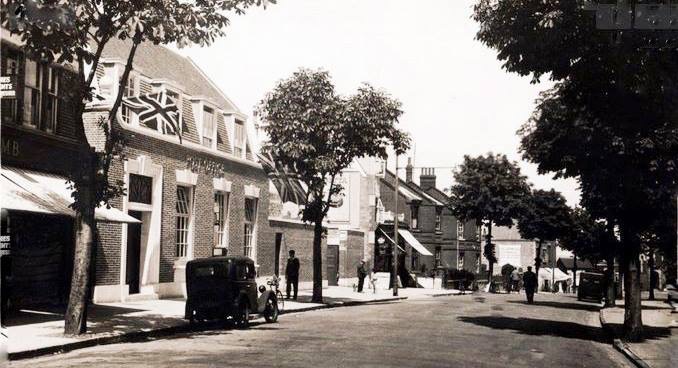
Dovercourt Post Office
At the entrance to the Post Office she was met by a messenger boy who handed her a telegram from the Postmaster General. Having read this, the Mayor proceeded to unlock the main door of building which she then formally declared open.
In declaring the building open, the Mayor said they were all very pleased to have such very fine buildings as had been erected at Harwich and Dovercourt.
Inscribed on the golden key presented to the Mayor was; “Harwich and Dovercourt Head Post Office, opened 17th July 1934, by the Mayor of Harwich, Mrs. R. Hill, J.P.”
Library
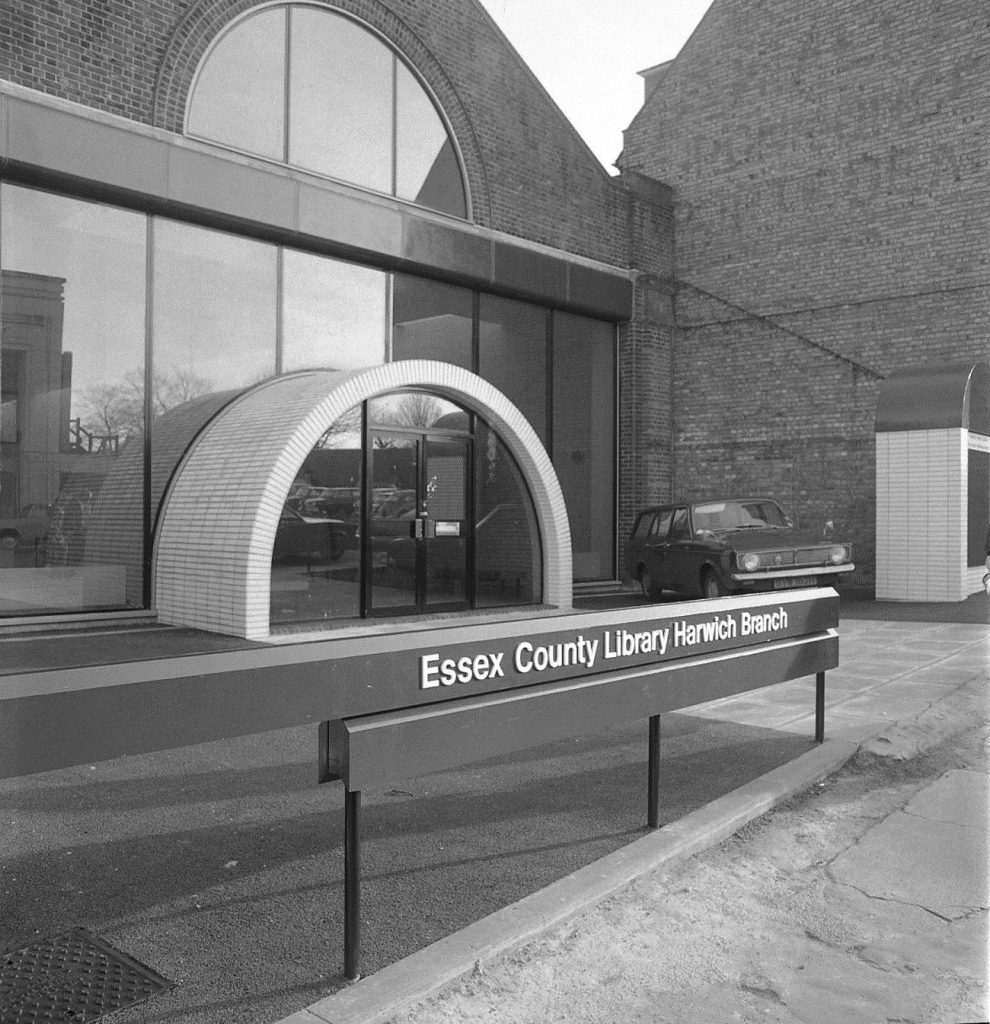
New Library
After a long and determined quest Harwich and Dovercourt Public Library has acquired attractive, centrally-situated premises which are a considerable asset not only to its 8,000 plus regular borrowing readership but also to the area as a whole. It was on May 8 1975 that Mr S. Cornish and his staff of six moved from, the dreary old Victorian-style school in Waddesdon Road, which had housed the library since 1947, to their spacious new location in Kingsway with its eye-catching arched porch and bright interior. Previously an Eastern National bus depot which was purchased by Essex County Council for £ 11,250, the new library is an outstanding example of clever and imaginative conversion.
Total cost of the transformation and interior furnishings was £71,000. The former sliding doors in the front elevation have been replaced by lightly-tinted anti-glare plate glass and the distinctive arched porch way with white ceramic facings echoes the high curved window which has been retained from its original design.
Inside the architect has used the 3,700 sq. metre ground area to maximum advantage with an open-plan layout that combines simple, uncluttered elegance with friendly informality.
The opening of the new library is an especially notable occasion when one remembers that as recently as 1943 Harwich and Dovercourt was the only borough in Essex and almost the only one in England without a public library service. During the 18th century the Rev Curtis assembled a library at Dovercourt Church but it was discontinued when he moved to Wales.
Old Customs House
14 West Street.
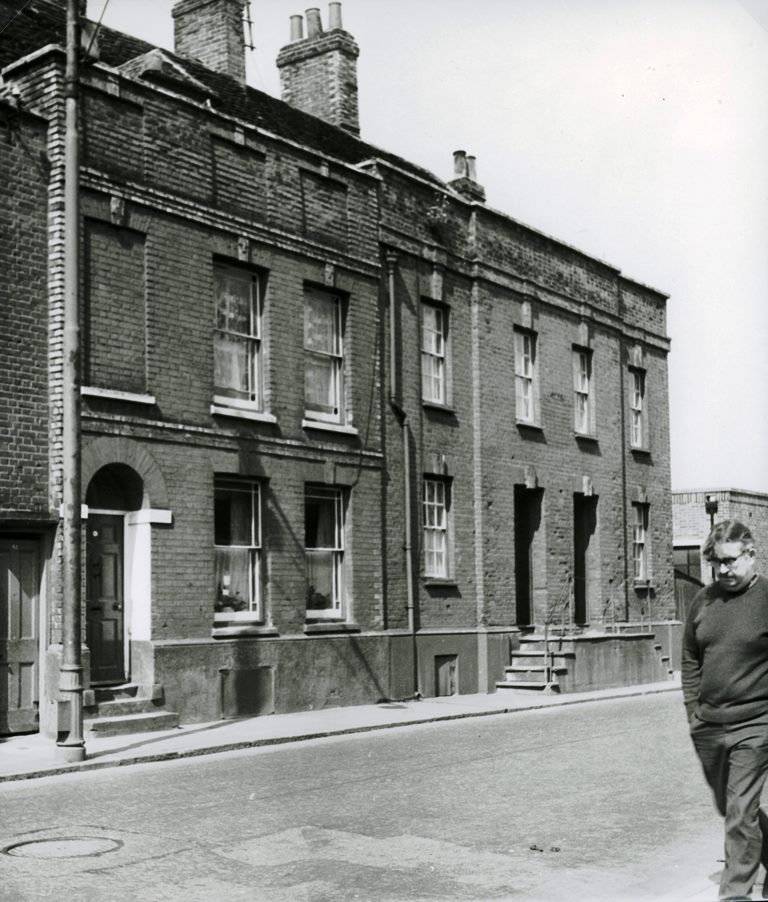
Old Customs House
Two early Georgian houses were converted into a Custom house around 1798. It remained the centre of customs operation until 1935. The coat of arms above the door has been removed but you can still make out the markings today. Prior to 1932 there existed a free trade area and so the work of the customs was quite light, however with the passing of the Import Duties Act of 1932, a levy of 10 percent was placed on all imports which led to a vast increase in H.M.Customs workload. The premises soon became too small to cope with this increase and the customs operation was moved to Hamilton House in nearby Parkeston. (Hamilton House had been built as an engine drivers lodgings then used as a corset factory, prior to its conversion to a custom house) In the 1970’s customs moved to a purpose built offices in Dovercourt, adjacent the Tower Hotel.
Park Hotel
14 Orwell Terrace, Dovercourt.
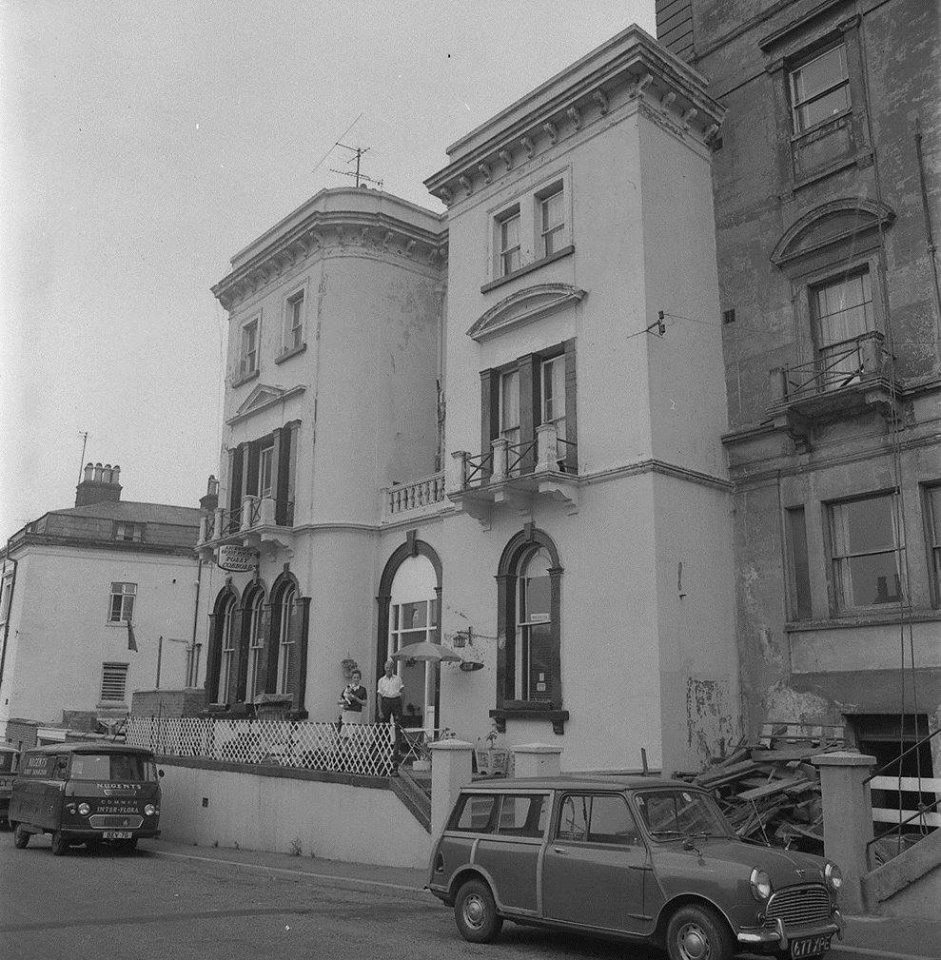
‘UHU’ Hotel
The hotel was built in 1864 of roman cement-covered brickwork with roofs behind high parapet. 3 storeys with basement. Exterior: front elevation is of 3 unequal parts with wide projecting block at NW end, central narrow recessed part and wider projection to SE. Plain parapet and modillioned cornice with stack over NW flank. Recessed part has, on second floor a double-hung sash window with moulded plaster surround. First floor has narrow moulded plaster surround with C20 plain glass window. Ground floor projects with Roman cement balcony in front of first floor window. Semi-circular moulded arch on pilasters and with keystone and C20 entrance door with side lights. North-west projecting part has quadrant curved corners and 2 double-hung sash windows in moulded plaster surrounds on second floor. First floor has tripartite arrangement of a narrow segmental-arched double-hung sash, either side of a flat-headed double-hung sash with combined plaster surround and triangular pediment over centre. In front of this is a tripartite divided balcony with wrought-iron cross balustrade on consoles. Ground floor has 3 semi-circular-arched linked double-hung sash windows. South-east projection has pair of linked, small, double-hung sash windows on second floor. First floor is linked by plaster surround to above and has 2 tall double-hung sash windows with pilasters and segmental pediment. In front of this is similar balcony on consoles. Ground floor here has semi-circular arch-headed double-hung sash window with keystone, margin glazing bars and consoles under sills. Irregular rear elevations probably result of land ownership and of 3 unequal parts with narrow central projection. Metal C20 escape stairs to second floor. Fenestration generally as front with semi-circular-arched windows to ground floor (over basement) and to projection. Raised terrace to Orwell Road with stone slab paving, stone curb and 2 lateral flights of stone steps. Iron handrail as No’s 1-13 but more complete. 2 entrance piers with Roman cement cladding and return wing at SE end. Inside, original dogleg staircase survives with cast-iron balusters and wreathed handrail.
In the 1960’s it was known as the ‘UHU’ Hotel which was ran by Les & Ann Hostler.
Possibly the last completed part of John Bagshaw MP speculation, 1854, of Dovercourt New Town.
The Park Hotel was demolished in January 2009. It had stood empty for several years and was considered to be beyond economic repair.
The Park Pavilion
On the edge of Cliff Park where Barrack Lane diverges from Main Road lies a cluster of buildings which proclaim their War Department origins by their architectural style. The buildings forming this establishment were retained and have become the united services club, and most prominent, the community Centre. The community Centre embraces a somewhat labyrinth brick building flanked as it’s western end by a small timber hut behind a brick frontage and very large light steel framed Drill hall clad with corrugated iron externally and lined with match boarding internally, all fixed to timber studwork between the steel supports columns. Half the floor of the hall had been covered with hardwood timbers; the rest was as the army had left it, including traces of the foundations of a large gun.
Volunteers had built a fair sized stage at the eastern end and there was bar and other essential accommodation in outbuildings at the rear. The hall accommodated various functions ranging from the weekly disco to the dog handlers class, old folks gatherings, dancing classes, shows and exhibitions.
Pier Hotel
Festively painted three story’s with an octagonal belvedere perched on the slope of the roof. 37 year old ex-Londoner and businessman John Brice saw commercial possibilities; in 1850 he became a publican and purchased the old brewery site. Brice’s plan was to open a Hotel near the quay within close proximity of the Railway lines and accessible for travelers arriving and departing from the pier, Building work began in 1860 despite objections from other publicans he was granted a liquor license.
On the 4th September 1860 the Pier was open for business, originally regarded as unnecessary and a failure, Harwich’s Pier hotel was transformed into a building of international Repute and is now classified as; an eye catching building of merit’… A significant local facility, playing a crucial role in supporting local enterprise.
Police Station
The importance of Harwich changed significantly with the arrival of the railway station in 1854 and later in 1883 when Parkeston Quay was opened. Probably it was the significance of the town to travelers and the increase in population which prompted the need to build such a substantial new Police Station complex. The site was designed as a self-contained law enforcement Centre complete with court offices and accommodation for many police officers.
Plans for the proposed new Police Station were drawn up by the County Architect, Frank Whitmore in April 1913 and copies of some of the plans hang today on a wall within the building. This purpose built Police Station comprised of a basement, first and second floors and a roof space, referred to as the attic and part of this was as single Police Constables’ Quarters.
The Basement was divided up into various rooms to house the resources necessary to run such a large complex. These included a Weights & Measures Room, 2 Wash Houses complete with toilets, Store Rooms, and a Bicycle Store, a block of terraced houses was created at the back and to the west of the Police Station which accommodated three married constables and one married sergeant.
The Redoubt
The Redoubt was built between 1808 and 1810 to protect the port of Harwich against the threat of Napoleonic invasion. The Redoubt is of circular shape, approximately 200ft in diameter, with a central parade ground of 85ft diameter. Hoists were used to lift shells from the lower level to the gun emplacements. Though difficult to imagine as it is now surrounded by houses, when the Redoubt was built it was on a hill top with free views in all directions. A house was demolished to make way for the Redoubt, and a large elm tree – used by ships as a navigational mark was also removed. Originally armed with ten 24-pounder cannon, the Redoubt was remodeled in order to accommodate increasingly heavy guns, as technology and the perceived threat changed. In 1861-2, work was carried out to accommodate 68-pounder cannon, and the emplacements were strengthened by adding granite facing to withstand improved enemy artillery. Only a decade later in 1872, three of the emplacements were altered to take enormous 12 ton RML(Rifled Muzzle Loading) guns. In 1903, three emplacements received 12 pounder QF(quick firing) guns.
Despite this ongoing modernisation, the Redoubt never fired a shot in anger. It is also probable that its strategic importance declined towards the end of the 19th century with the construction of the more powerful Beacon Hill Battery just to the south. In the 1920s the area around the Redoubt – previously kept clear to provide fields of fire – was bought by the Town Council. This land is used for allotments. The Redoubt itself was allowed to fall into disrepair.
The Redoubt was briefly taken back into military service during World War II, when it served as a detention centre for British troops awaiting trial. Examples of the graffiti left by the soldiers can still be seen in some of the rooms.
Following World War II the Redoubt was used by the British Civil Defence organisation who used it until they were disbanded. That was the end of the Redoubt’s military service.
Warner’s Holiday Camp
In January 1937 Harwich Borough Council purchased 76 acres of land between the low road and the foreshore at a cost of £ 7,500. 40 acres was leased to the Dovercourt Bay Holiday Camp & Lido and an additional 18 acres was used to Create football and cricket playing fields. Dovercourt Bay Holiday Camp was owned by Major H.J. Warner, it opened in July 1937, accommodation was built for 1,500 guests and facilities included a dining room, bars, ballroom, swimming pool, putting green, tennis courts, boating lake.
Over 6,000 visitors holidayed at the camp over the first season. Between October 1979 and October 1987 Warner’s Holiday Camp was used for the filming of the popular comedy series Hi De Hi. During the filming of the 58 episodes the camp became known as Maplin’s Holiday Camp.
Despite regularly receiving 11,00 holidaymakers each year, the camp was closed for good at the end of the 1990 season. The site was later demolished for housing.
Manufacturing
In mineral wealth Essex is not rich, clay for brick making, chalk for making lime, and septaria for making cement, Harwich also produced Coke and yeast.
Over the years Manufacturing in Harwich and Dovercourt has declined. Here details some of the Manufacturing in the town over the years.
Pattrick and Sons
Well known for their Portland cement brick making business they were a major employer in the town during the 19th century the plant, which had previously made Roman Cement using the large deposits of septaria around Harwich, commenced Portland cement manufacture around 1867. There were several others around the East Anglian coast in the pre-1895 period. John Pattrick had inherited the business from his father in 1872.
Stone was taken from mill bay and transported by sea to Phoenix Wharf, today known as Patrick’s lane, for processing into cement. The site consisted of 12 cement kilns, drying flues, grinding mill and mixing rooms as well as workshops engine and boiler house. By 1881 it had 14 bottle kilns and slurry backs, and this remained the complement until closure. Not all these were used for Portland cement, and the capacity might be estimated at 390 t/week. The plant primarily used water transport, with its own wharf on the Stour estuary, although, placed adjacent to Dovercourt station, it could also use the Great Eastern railway. Part of the site is now under housing, but most of it is still waste land, and some foundations are identifiable.
A 240 feet chimney, built in 1872 dominated the skyline until it was demolished at the outbreak of war in 1939.
The owner had financial difficulties and on the 29th May 1906 the site was sold to Groom & sons who were timber and coal merchants, they transferred there facilities from Harwich quay to the new site. The factory was eventually demolished in 1939.
Capital Wines
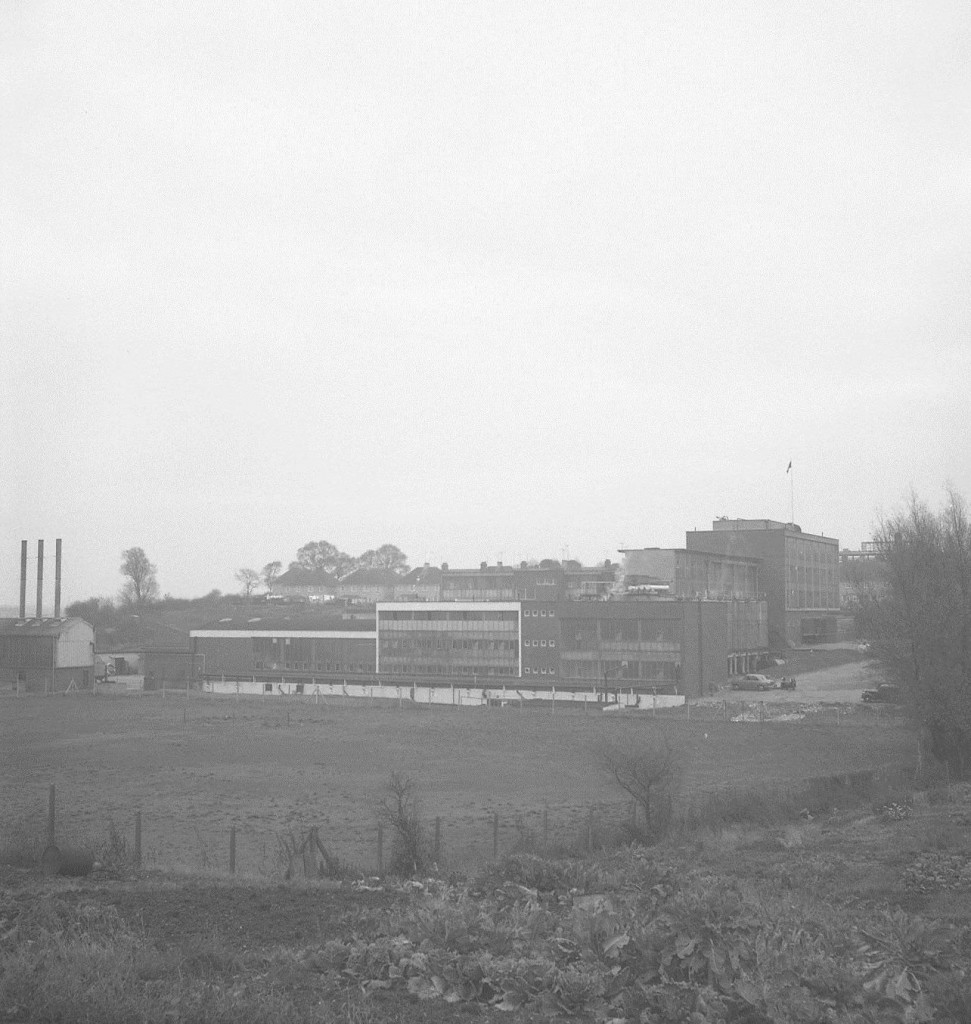
Capital Wines
Work commenced on the old Patrick’s cement factory in King George’s Avenue in 1949 and some eighteen months later the United Yeast Company commenced production. The factory would employ 120 men and some 30 women and in 1961 was described as one of the most up to date yeast factories in the country. The factory closed in March 1965 resulting in all 110 staff losing their jobs. The site was sold to capital wine agencies in 1969 and it was used as there Wine distribution base.
The site closed in the late 1980’s and was demolished in 1991.
The Harwich Gas & Coke Company

Demolition in 1965
On the 5th June 1854 Mr Francis hale officially laid the first brick for a gas works. A gas storage holder was on the site and could store 10,m000 cubic feet of gas, The barges and coasters would discharge coal for conversion into gas, coke and other products. In the first year of operation, 14 million cubic meters of gas was produced and by the turn of the Century it had increased to 20. And by 1945 the total was 67 million.
The end of the Harwich site came when pipelines connect Harwich with the Colchester supply,the works finally closed on the 31st March 1964 and demolition in 1965.
Bernard’s
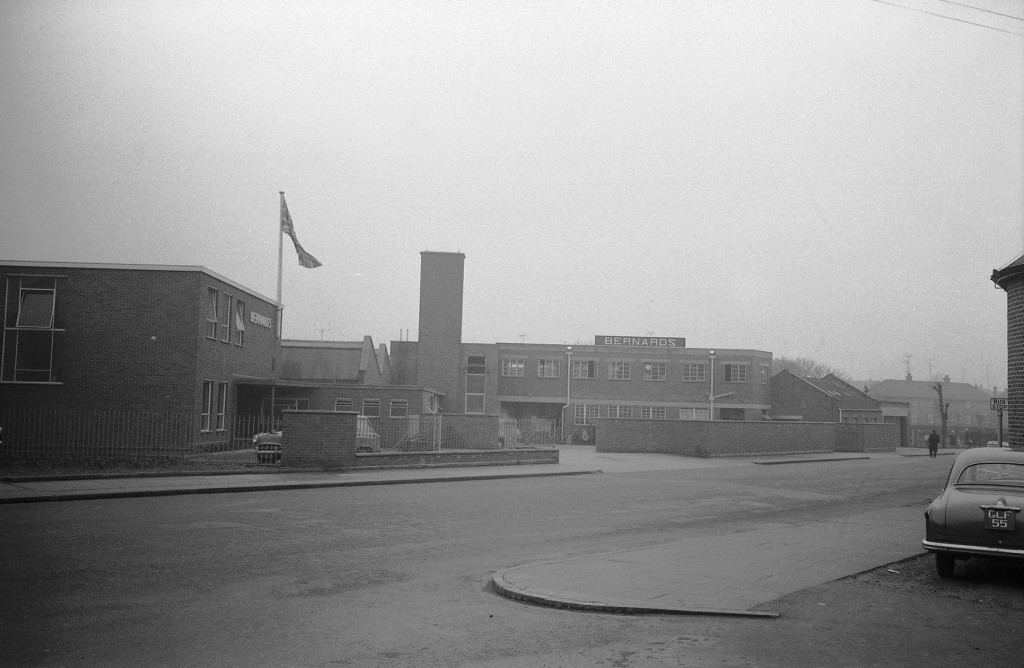
Bernard’s
Bernard’s of Harwich were well known throughout the royal navy because of their work and because of their name, Charles Firth Bernard founded his clothing business in 1897 at 69 church street Harwich. They had received the royal warrant for tailoring naval uniforms for the sons of Prince George. Charles died in 1907 and the business was then run by his wife until his sons were old enough to run the business. September 1930 the business moved into part of the ordnance buildings Which they purchased for £1,300.
A new factory was built on the site in 1939 but on the 17th of May 1941 incendiary bombs destroyed the building. The admiralty issued a priority licence and five months later the factory had been rebuilt.
During the Second World War naval uniforms plus other clothing were manufactured, the factory and office were damaged in the 1953 floods, further building extensions were completed in 1955.
The factory was divided into different sections; the Main section was the ground floor, where they use to stitch the uniforms together, upstairs was cutting room where they would shape out the uniforms.
In September 1978 the company was taken over by W.L.Pawson Ltd who withdrew in 1980 to be replaced by MPH the following year.
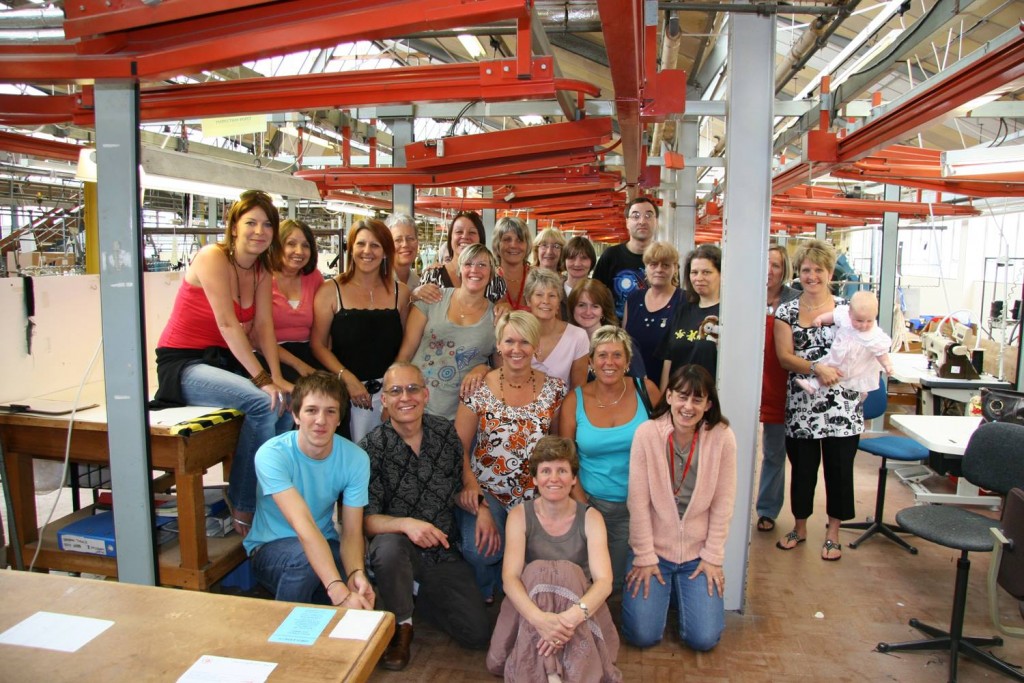
Staff on the Final day in 2007.
In 1993, the Hobson Group acquired the business. by 1997, the business was celebrating winning a £1.3million contract from the Ministry of Defence. The three-year contract saw the factory produce 27,000 Royal Navy uniforms and marked a turnaround in fortunes for the company, which had the previous year made 20 of its employees redundant and put its remaining staff on three-day weeks. But just a decade later, in July 2007, staff were left devastated when it was announced the company had gone into liquidation.
In 2016 the site was finally demolished for housing.
Memories.
I worked there straight from school putting waistband linings in trousers. 1971. The rolls in the canteen were great at break time, I remember Mr. Large. Ron Harris and Daphne. …oh and useless Eustace the prize draw where you could win a hairdo in the hairdressers at Church Street. I won once in 2 years. The radio was on all day while we worked. Happy days.
Some of the best times in my life spent in that factory, can remember sewing girls cardigan etc. sleeves up so they couldn’t get their arms through at home time lol.
I worked in the office and loved the crispy cheese rolls served in the factory canteen…funny what we remember.
Worked there also was really happy good crowd although Eileen Matthews always caught us having a crafty smoke in the toilets …very sad the place has been demolished .I remember Wednesdays when the sailors from H.M.S. Ganges use to visit used to make us girls blush and I also was fitting model for uniform for Princess Anne …Happy memories
Kettles
Mr. F.Kettle established a mineral water manufacturing business in 1891 in the cellar of the British Flag public house, the business had grown so big that a new premises was found in Stour road opposite the anchor public house in 1904, Fred Kettle had been the landlord of The British Flag for 24 years , following his death in 1923 the business was controlled by his son A.B.Kettle. Lydia Whitnall Recalls… he started his mineral water firm from the cellar of the British Flag in West Street, Harwich. nothing was too much trouble, if you ran short of minerals or cigarettes, it was delivered in a short time. They sold the best lemon squash in the area. I have a plaque in my hall of “F.Kettle and son, mineral waters”. and in a circle in the middle it says British Flag, which means that is where it all started. When people come to my door, i can see them glance up at the plaque I’m sure they are wondering why it is there. But, when i look at the plague, it provides happy memories of the small friendly family firms where you were a name, not a number on a computer.
On the 6th of October 1923 the building, machinery and workshop where all destroyed by fire. A new site was then found on the corner of Gwynne road opposite the park. Mineral water production ceased in 1986 and although the business continued as a Cash & carry drinks business the buildings where demolished in 1988.
Co-Operative Society
The Harwich and Dovercourt Industrial Co-operative society was formed in 1875. The society purchased Queen’s terrace in Grafton road in 1904, This was demolished and replaced by a new steam bakery which opened in 1905. Within the two floors there where a flour blender, and sifting machines. New machinery was installed in 1916. All building work was carried out by local builder Edward Saunders. The bakery finally closed in 1967 and was demolished in 1999.
Vacuumatic Limited
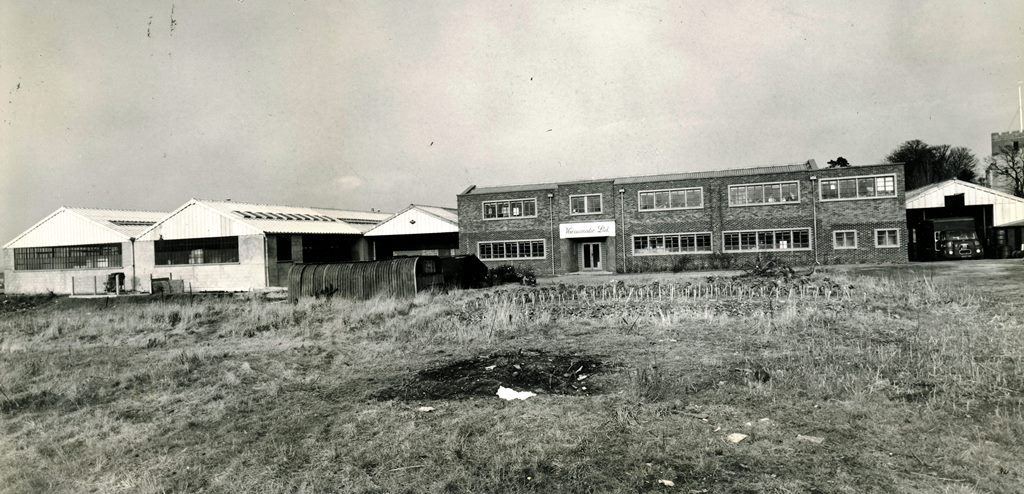
Vacuumatic
New factory at Church Farm, Upper Dovercourt, near All Saint’s Church
A need for the new factory has arisen from the world-wide demand for the bank note counting machines developed by Horwood-Cranston, Ltd – in future to be known as Vacuumatic Ltd- at their old existing factory in the old Post office building at Harwich.
27th of March 1951. A New factory was being built in Upper Dovercourt where the manufacture of bank note paper Counting machines would be carried out. a 5 acre site on church farmland and a 14,000 square feet factory was Built which opened the following year under the name Vacuumatic Ltd. A 10,000 square feet extension was built in 1954 with new offices completed in 1957. it was said to represent another step in the post-war development of Harwich and Dovercourt and an important increase in the activities of an established local Business. The machines were developed for Horwood Cranston limited at their existing factory in the old Post office building at Harwich.
Worldwide demand for the “magic” machines, which could count the paper at the rate of more than 100,000 sheets an hour, meant the company needed the new premises. the machine was the first of its kind in the world, and orders from banks in America, Canada, France, Poland, Holland and Spain had been made.
Factory Extension 1961.
To accommodate the additional machinery together with the extra assembly area, further extensions to the works of 12,000 square feet is now being completed. This extension is larger in size than the whole original factory built by Vacuumatic Limited in 1951. Since the original premises were erected four other extensions have been added and when the existing works is finally finished, the factory will be nearly four times its original size.
Social Club
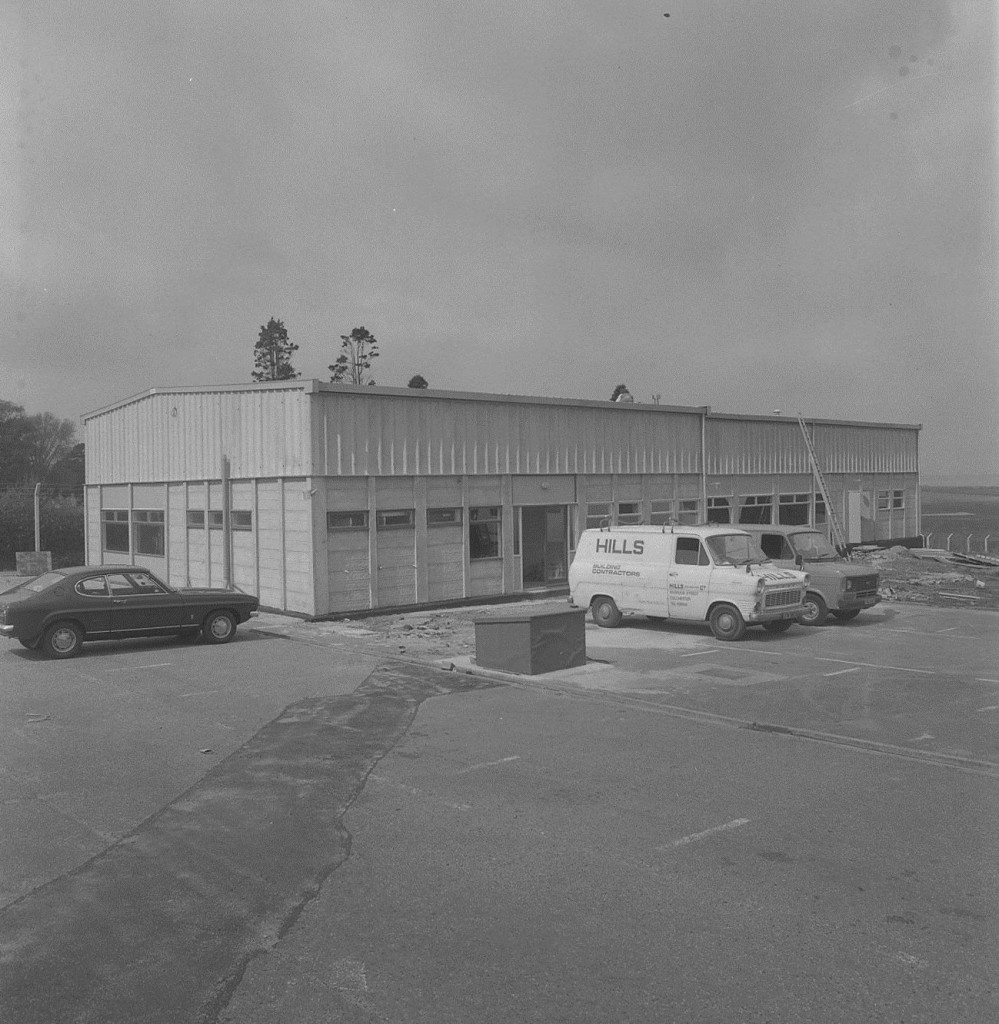
Vacuumatic Social Club
On the social side of Vacuumatic Limited, it has been found necessary to extend the existing premises and work is now going ahead to increase the size of the club by half the existing floor area. When finished the social club will be one of the largest in the area and will have one of the best dance floors. It will also have seating accommodation for 200 persons.

Last load to leave factory 06.12.1982
Reorganisation in 1983 meant changes to the Dovercourt site, with Sheffield based Filing machinery business which amalgamated with the labelling nit to form PPM Albro, The site suffered a major setback when the company was sold and transferred to Kent.
Today the site remains empty and the buildings have been demolished. The developer hopes build a mix of 36 one and two-bedroom flats and 30 houses .
Crisp Factory
Mr V.Pilbeam established the East Anglian Crisp factory at tollgate just after the end Of World War 2, as the business expanded they employed 15 staff working two shifts And producing 1,000 bags of crisps each week. The company moved premises in 1949 Into the empty MacBride’s site in Albemarle street.
The Foster Manufacturing Company
The Corset factory in Foster Road, Parkeston had been the custom house for a good many years. The factory opened before the 1914 war, making ladies corsets, bodices and underwear threaded with ribbon, and suspenders for men and women. When the war started, it made khaki shirts, bandoliers for the ammunition, and hospital garments for the wounded soldiers.
Norprint
The History of Norprint began in 1956 when the London firm of Dapag (1943) Ltd, who produced tickets, labels and overprinting machines, had difficulty obtaining premises in the city. they decided to build a factory at Valley Road, Dovercourt and gradually moved their business out of London.
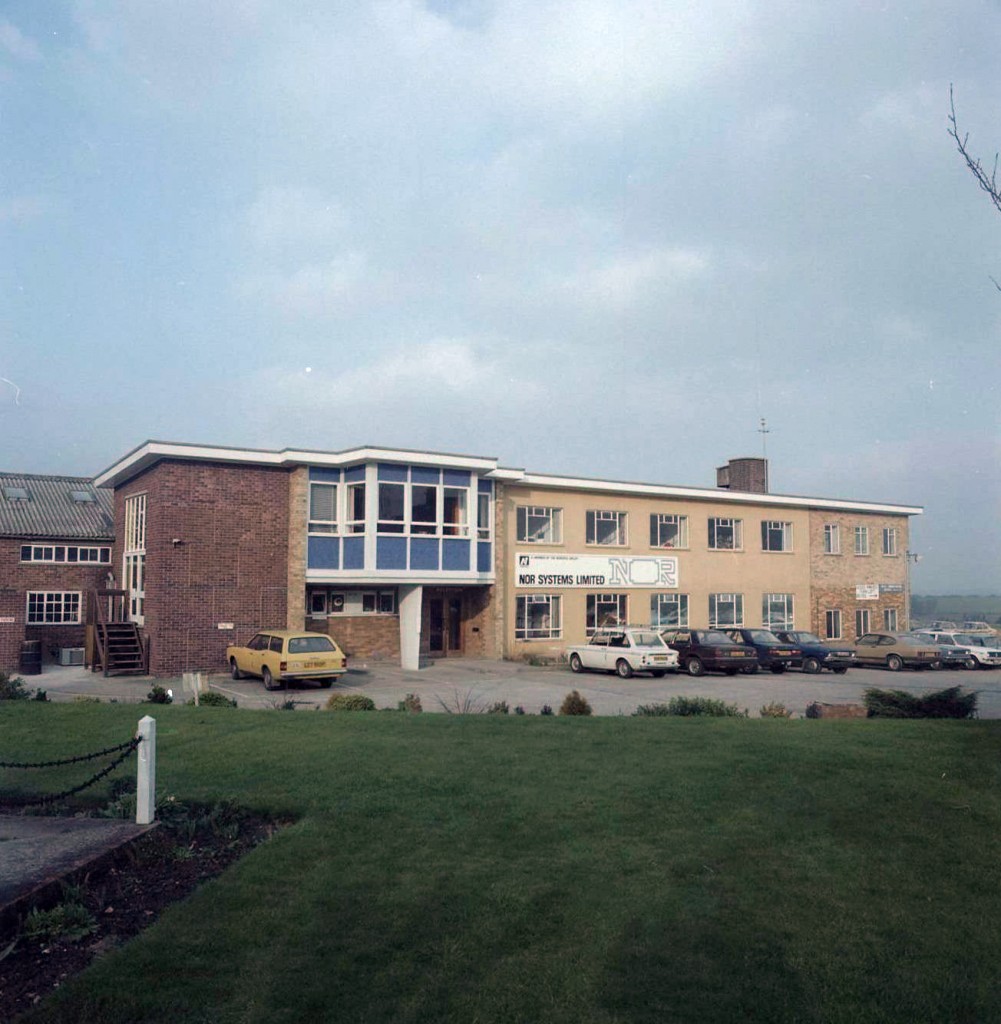
Norsystems
The machines produced by Dapag called Tickopress, were so successful that the company changed its name to Tickopress Ltd and in 1957 joined the Norcross Group. The London side of the company was eventually closed down in 1967 when Tickopress at Dovercourt and the Boston Company of Fisher Clark became Norprint Ltd. In early 1968 it helped to start the I’m Backing Britain campaign, by running off the promotional stickers for free. Before the days of barcodes in supermarkets, Norprint made hand-held price labelers, used by the main supermarkets; these were made in Harwich. Norprint produced tickets for airlines and the London Underground. It was owned by Norcross plc.
On 25 June 1998 Norcross put Norprint up for sale. In July 1998 Norprint was bought by a management buyout for £13.7 million. After the buyout it was known as Norprint Labelling Systems and today trades as Sato UK Ltd.
Fairview Caravans

Official opening 1963
A Romford based caravan maker chose a new 6 acre factory site in valley road. The choice of site of the factory was made after very careful thought and after consultations with many planning authorities and the Board of Trade it was decided that Harwich offered the best facilities for present production and expansion in the future. Production commenced in March 1963 with a staff of over 100 manufacturing Touring and residential caravans., production increased and a new extension was opened in 1964. A serious of strikes the same year led to ugly scenes On the picket lines 68 staff went on strike and a month later the strikers where dismissed. The dispute officially ended on March 19th 1965. Financial repercussions from the dispute and the economic squeeze let to the factories Closure in 1971.
The Local Newspaper Reported. Bidders from miles around descended on Fairview caravan’s factory in Dovercourt for a four day auction of the liquidated firm’s effects. equipment valued at more than £25,000 changed hands during the sale. When the factory closed 105 people were laid off, but some were re-employed Briefly to help clear the goods. Michael Hammerton, the managing director of the firm, blamed the poor state of the home market for the collapse. He said it came after a two-year fight to stay in business.
Carless Capel & Leonard
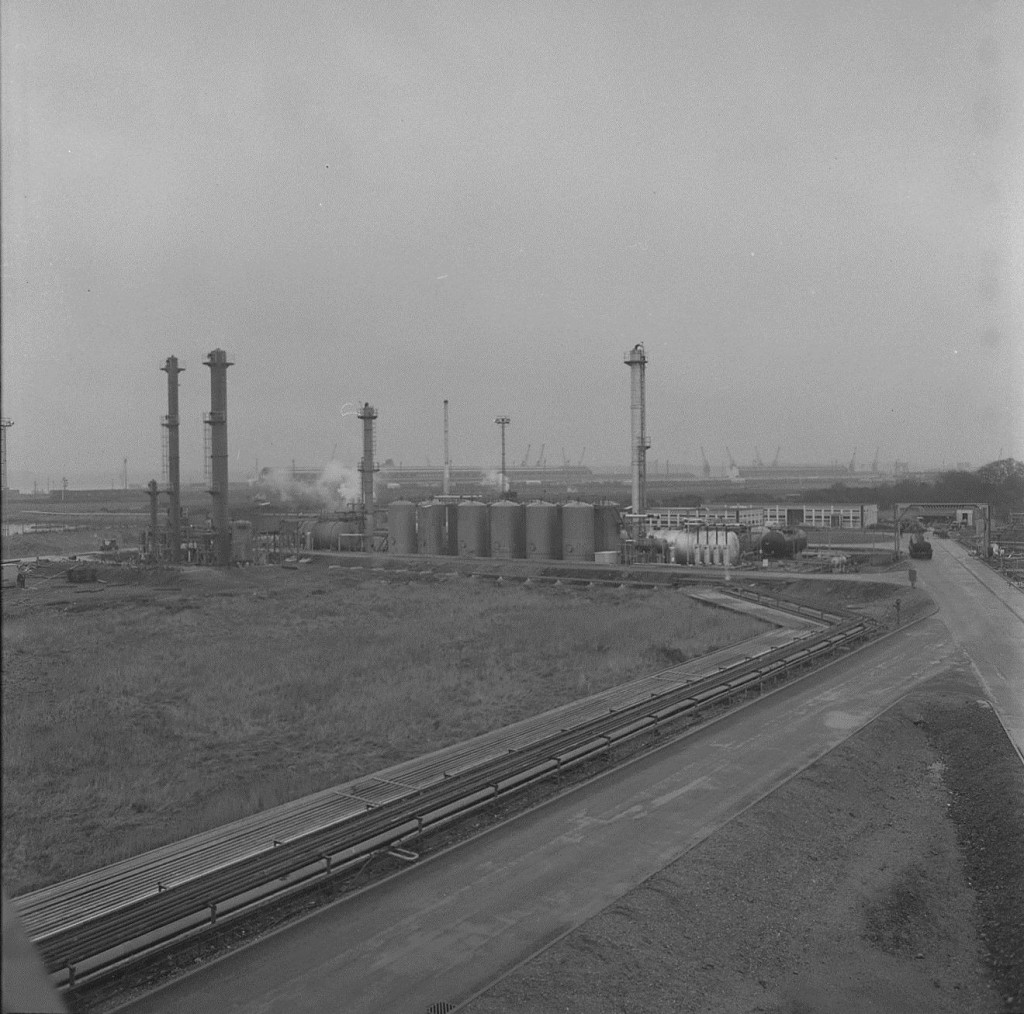
Carless Refinery
A new refinery was built on land owned by British railways and in 1962 the pipelines where laid to connect the oil refinery with a new tanker berth at Parkeston quay. The first tanker to arrive at the new berth was the 807 gross tone “Tillerman” on the 27th of February 1964 which would discharge 1,000 tons of petroleum spirit into the Refineries storage tanks.The Harwich Solvents Refinery, developed by Carless, Capel and Leonard Ltd, on a 25 acre site adjoining Parkeston Quay, was officially opened by Mr. Julian Risdale, M.P. for Harwich, on the 23rd of June 1964. more than 100 guests from the civic and professional fields included the chairman of Tendering Rural District Council, Mrs. M.C. Wright, and the Mayor of Harwich, Councillor H.Gochin.
In the early days the company were the pioneers of petroleum. The refinery had been built to give greater scope in the manufacture of the company’s products, and was an addition to the refineries at Hackney Wick and Bow in London. Through modern instrumentation and automation all operations were directed from a central control room.
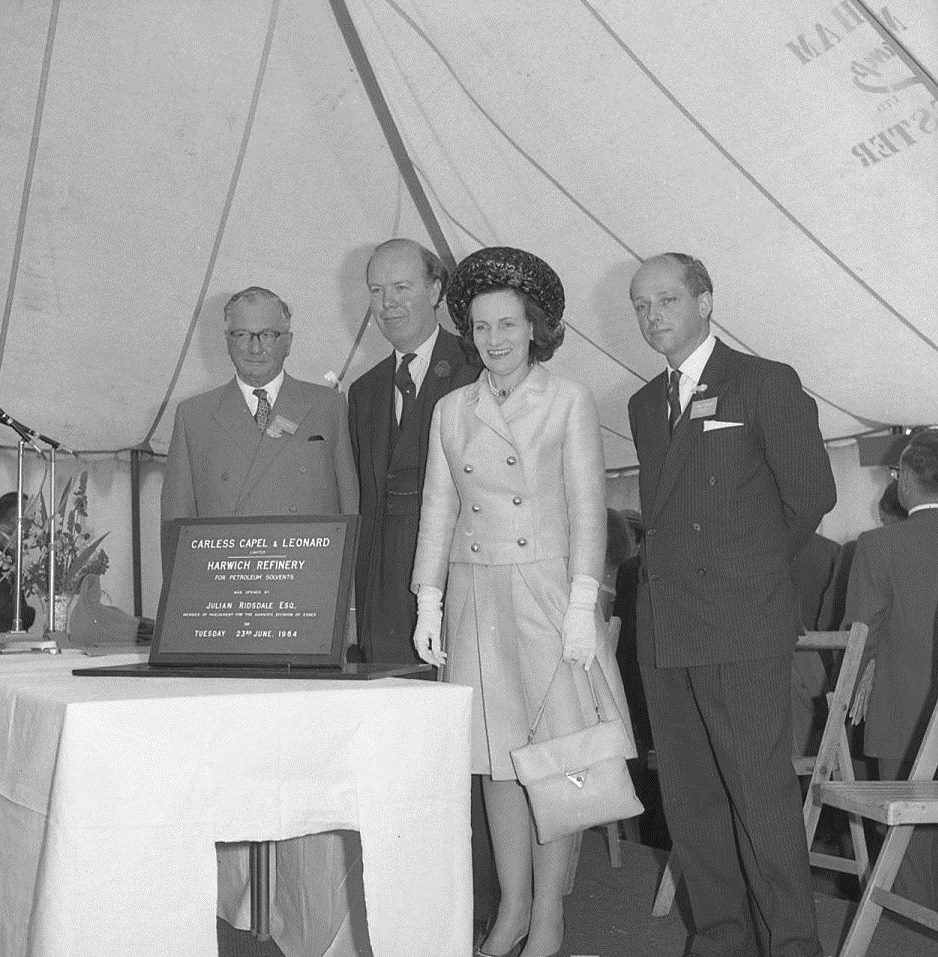
Official Opening
Before the unveiling of the plaque to mark the opening, Mr. Risdale spoke of the increasing build-up of Harwich as a port, and congratulated British Railways on a progressive policy of leasing surplus land. He looked forward to the day when there would be a number of small firms on the mudflats of Parkeston. This would act as an advertisement to British industry for people from the Continent entering the port. Mr. Risdale said the refinery firm was a small private one, which was doubling its size. He congratulated the directors on the faith and confidence they had shown in the Harwich Area and in the future.
“It is good to know there is a place for the small specialised firm in these days when you look around and see big units growing up. I have always had faith in the small firm and the small man in spite of the bigger industries that we have. It is good to know your firm is showing an example of what can be done by a highly specialised firm in the industrial field”. he said.
Following lunch at the Parkeston Grille the party were entertained on the Rowbotham tanker, Oarsman, which had discharged at the new oil terminal at the western end of Parkeston Quay.
The company still remains today as Petrochem Carless.
Mercedes Benz
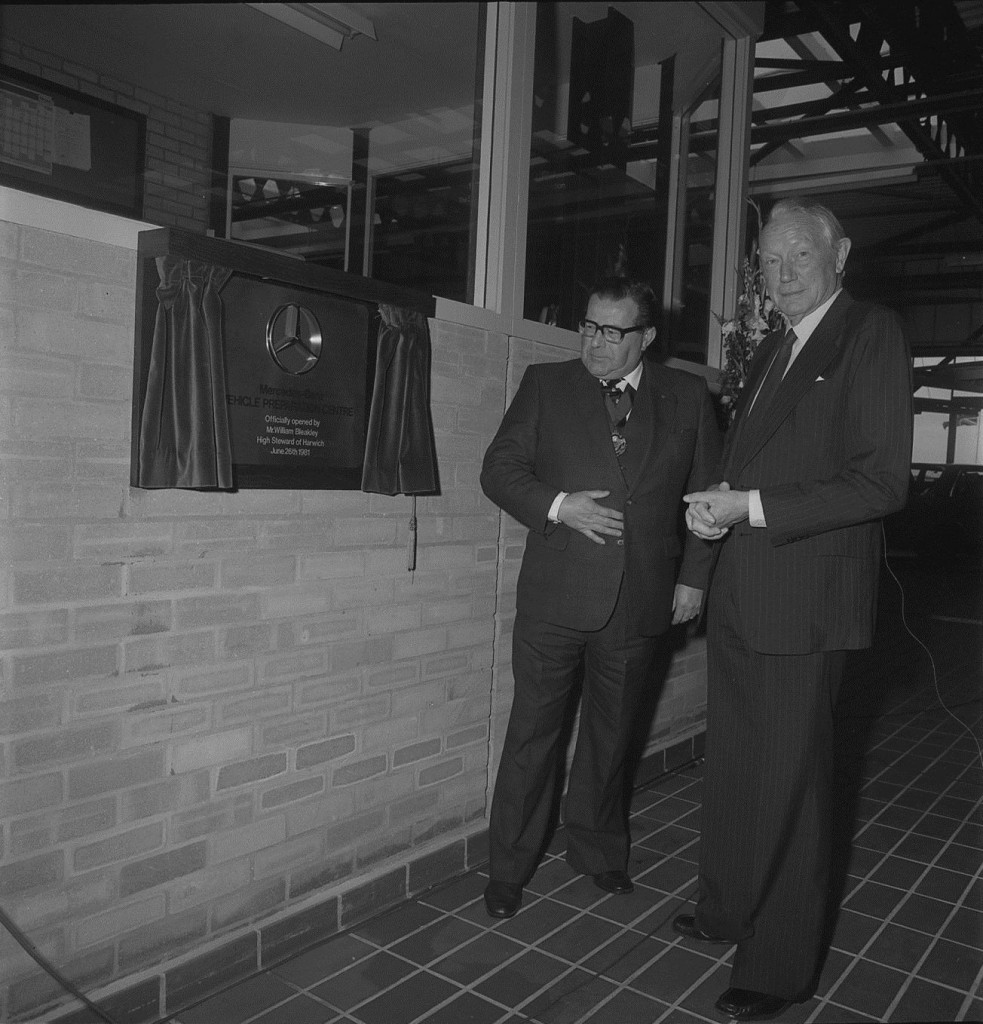
Official Opening
Harwich’s High Steward Mr William Bleakley officially opened the centre on the 26th June 1981, The centre provided jobs for Harwich and Dovercourt at at time when the town desperately need them. It specialised in making sure that cars were in first class condition before being sent to dealers in the UK. Cars were brought into the country from Zeebrugge on the Harwich train ferries, once in the centre, they were dried and put over inspection pits and checked for damage or mechanical defects. Mr Eric Cromwell, the Mercedes UK managing director, said “The decision to build the new centre at Harwich was based on a long and stable relationship with the port and its people.” the plant had cost £1.5m to build and could handle 15,000 cars per year.
The plant closed in 1994 when Mercedes transferred their port operation to Purfleet.
“It is good to know your firm is showing an example of what can be done by a highly specialised firm in the industrial field”.
Photo Gallery
We hope you will enjoy browsing these wonderful photographs of Harwich and Dovercourt.
We are adding more information to this site on a regular basis, if you wish to submit any photos or provide any information, please use the contact page at the bottom of the screen.
